Special Report
Most Dangerous States in America
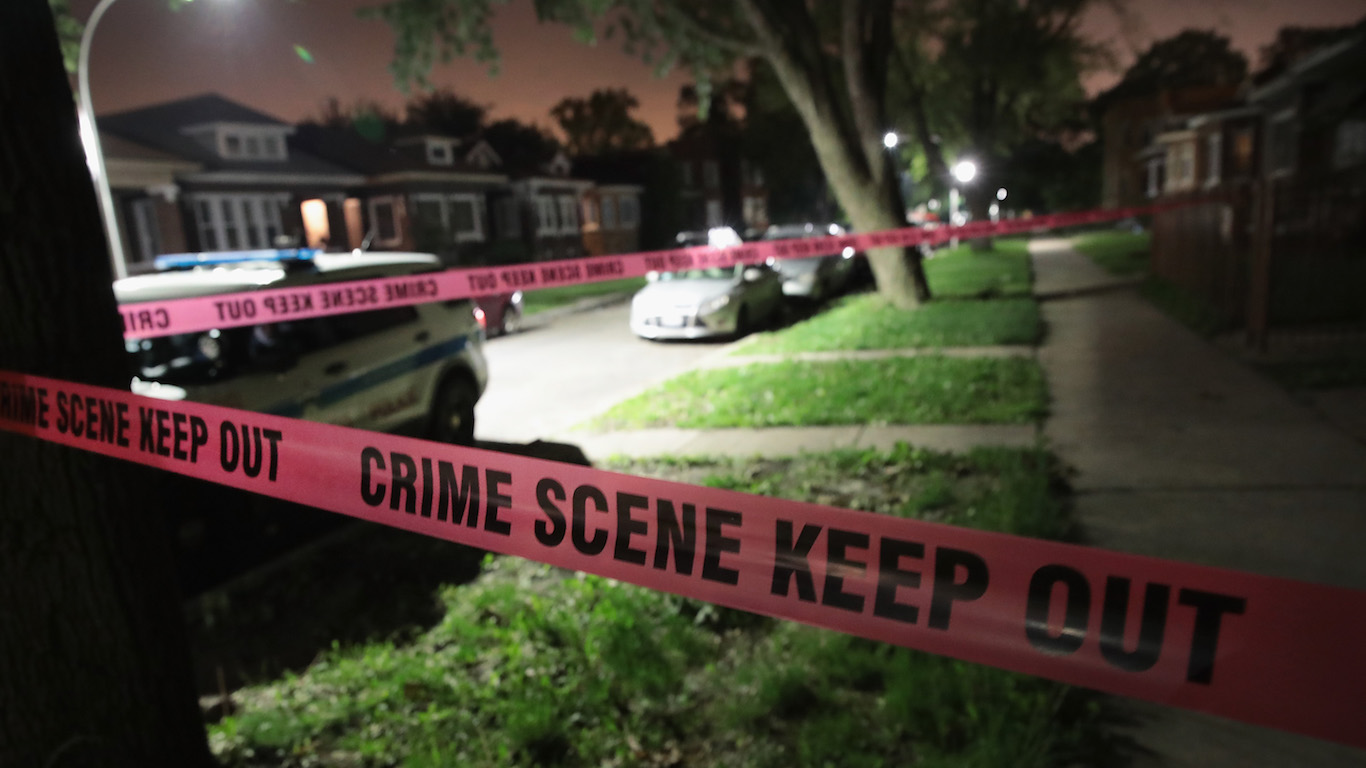
Published:
Last Updated:

Even as the U.S. population increased by 2.3 million from 2016 to 2017, the number of violent crimes fell by approximately 2,400 incidents. Experts project that the violent crime rate will continue to decrease in 2018 as part of the long-term decline that began in the 1990s.
While violent crime in the United States is close to its lowest point in nearly 50 years, some parts of the country are stuck in the past. The violent crime rate — the number of reported incidents per 100,000 — in some states remains at a level not seen on the national scale since crime peaked in the late 1980s. Violent crime in these states is driven in large part by gun violence in major cities.
While the relationship between violent crime and wealth is complicated, crime tends to be more common in areas with reduced access to economic opportunities. Many of the states with the highest incidence of violent crime have low educational attainment rates as well as high rates of poverty and unemployment.
To determine the most dangerous states in America, 24/7 Wall St. reviewed the 2017 violent crime rate for all 50 states with data from the FBI’s Uniform Crime Reporting Program. The violent crime rate consists of the number of murders, rapes, robberies, and aggravated assaults per 100,000 residents.
Click here to see the full list of the most dangerous states in America.
Click here to see our detailed findings and methodology.
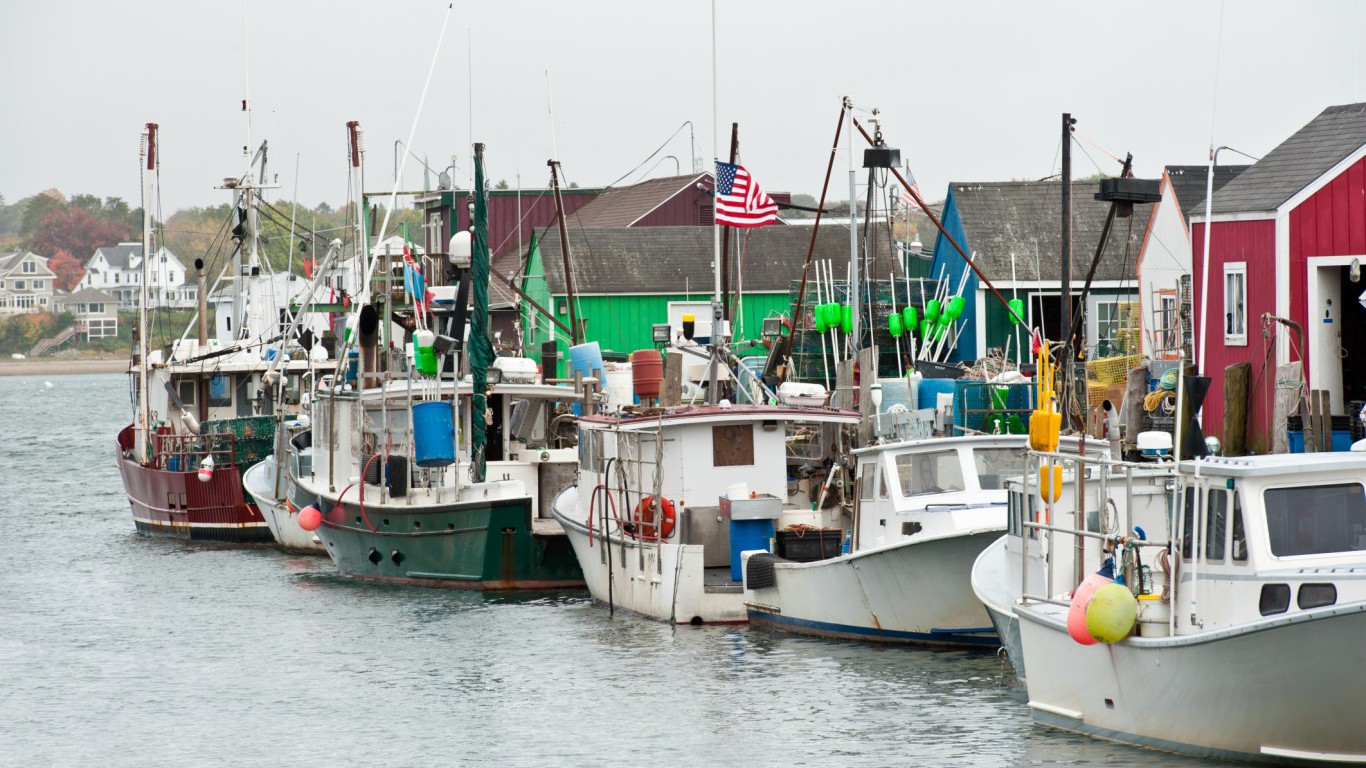
50. Maine
> Violent crime rate: 121 per 100,000
> Total 2017 murders: 23 (6th fewest)
> Imprisonment rate: 380 adults per 100,000 (5th lowest)
> Poverty rate: 11.1% (16th lowest)
> Most dangerous city: Biddeford
Maine is the safest state in the country. There were 121 violent crimes for every 100,000 state residents in 2017, less than a third of the national violent crime rate of 394 per 100,000. As it is across the United States as a whole, aggravated assault is by far the most common type of violent crime in Maine. Still, the state’s aggravated assault rate of 65 incidents per 100,000 people is a fraction of the national rate of 249 per 100,000.
Crime is often concentrated in more densely populated urban areas. Even in Biddeford, the most dangerous city in Maine, violent crime is less common than it is nationwide.
[in-text-ad]

49. Vermont
> Violent crime rate: 166 per 100,000
> Total 2017 murders: 14 (3rd fewest)
> Imprisonment rate: 340 adults per 100,000 (the lowest)
> Poverty rate: 11.3% (19th lowest)
> Most dangerous city: Rutland
Vermont’s violent crime rate jumped 21.5%, from 137 incidents per 100,000 people in 2016 to 166 per 100,000 in 2017, the largest increase of any state. Despite the increase, Vermont remains one of the safest states in the country, second only to nearby Maine.
Safer parts of the countries tend to have healthier job markets. In Vermont, just 2.8% of workers are unemployed, well below the 3.7% national unemployment rate.

48. New Hampshire
> Violent crime rate: 199 per 100,000
> Total 2017 murders: 14 (3rd fewest)
> Imprisonment rate: 410 adults per 100,000 (6th lowest)
> Poverty rate: 7.7% (the lowest)
> Most dangerous city: Manchester
In New Hampshire, there were 2,668 violent crimes reported in 2017, effectively unchanged from 2016. As the population increased over the same period, however, the violent crime rate declined from 200 incidents per 100,000 residents to 199 per 100,000, a decrease of 0.6%.
New Hampshire has the lowest murder rate, by far, of any U.S. state, and it continues to decline. There was just 1.0 murder per 100,000 state residents in 2017, down 28.6% from 1.4 per 100,000 the year before — one of the largest declines of any state.
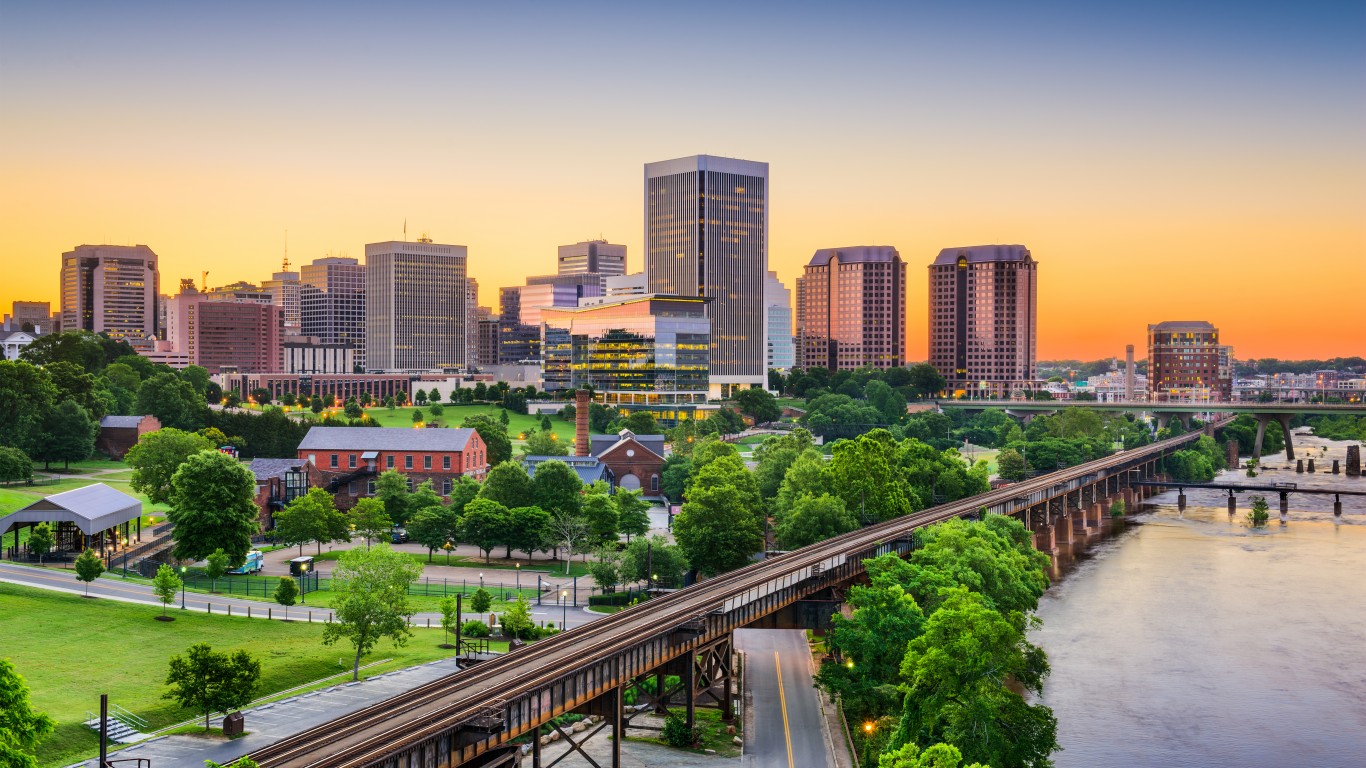
47. Virginia
> Violent crime rate: 208 per 100,000
> Total 2017 murders: 453 (15th most)
> Imprisonment rate: 880 adults per 100,000 (16th highest)
> Poverty rate: 10.6% (11th lowest)
> Most dangerous city: Petersburg
Virginia’s violent crime rate declined 5.4% from 2016 to 2017. The rates of murder, robbery, and aggravated assault were all lower in 2017, and in many cases the declines were some of the largest of all states.
Though Virginia is one of the safest states in the country, the state’s murder rate of 5.3 homicides per 100,000 residents is in line with the national rate. The murder rate in two Virginia cities, Petersburg and Danville, is greater than 30 per 100,000 residents.
[in-text-ad-2]

46. Kentucky
> Violent crime rate: 226 per 100,000
> Total 2017 murders: 263 (22nd most)
> Imprisonment rate: 1,010 adults per 100,000 (9th highest)
> Poverty rate: 17.2% (5th highest)
> Most dangerous city: Louisville
Though the number of aggravated assaults per capita inched up slightly in Kentucky from 2016 to 2017, the incidence of rape, robbery, and murder declined slightly. As a result, the overall violent crime rate fell from 236 incidents per 100,000 residents in 2016 to 226 per 100,000 in 2017.
Even in relatively safe states like Kentucky, crime can be common in densely populated urban areas. In Louisville, a city home to over half a million people, there were 647 violent crimes for every 100,000 people — well above the national violent crime rate of 394 per 100,000.

45. Idaho
> Violent crime rate: 226 per 100,000
> Total 2017 murders: 32 (8th fewest)
> Imprisonment rate: 900 adults per 100,000 (13th highest)
> Poverty rate: 12.8% (25th lowest)
> Most dangerous city: Garden City
Idaho is one of the safest states in the country. There were 226 violent crimes for every 100,000 state residents in 2017, well below the national violent crime rate of 394 per 100,000.
Idaho’s 2017 violent crime rate represents a slight improvement from the previous year — partially due to a falling murder rate. The number of murders fell by a near nation leading 35%, from 49 in 2016 to 32 in 2017, which is even more impressive considering the population grew in 2017.
[in-text-ad]
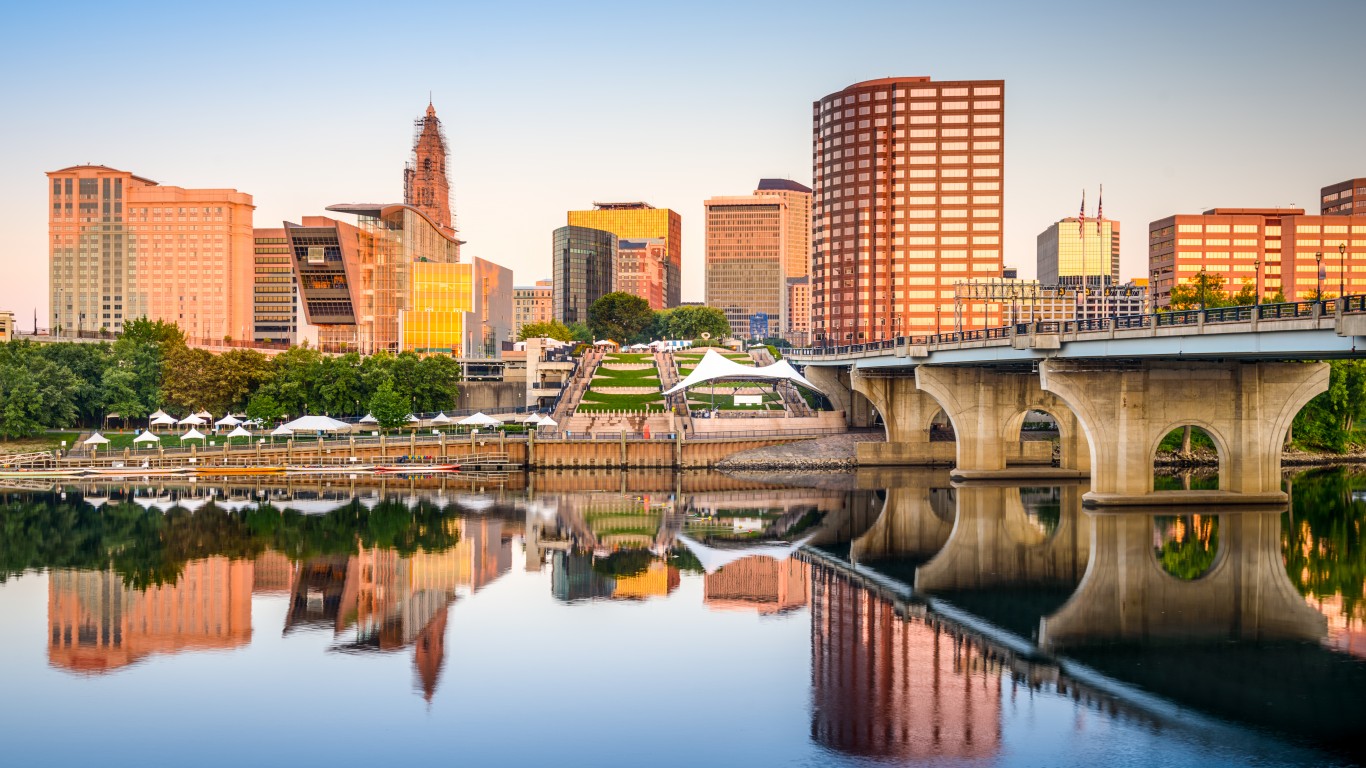
44. Connecticut
> Violent crime rate: 228 per 100,000
> Total 2017 murders: 102 (16th fewest)
> Imprisonment rate: 530 adults per 100,000 (11th lowest)
> Poverty rate: 9.6% (5th lowest)
> Most dangerous city: Hartford
Connecticut’s violent crime rate increased very slightly from 2016 to 2017. This was due in part to the state’s spiking murder rate, which rose from 2.2 murders per 100,000 people to 2.8 per 100,000, a 27.3% increase. Still, Connecticut’s violent crime rate of 228 per 100,000 is well below the U.S. rate of 394 per 100,000.
Hartford is by far the most dangerous city in Connecticut. The city’s violent crime rate of 1,093 incidents per 100,000 residents is more than four times higher than Connecticut’s violent crime rate as a whole.
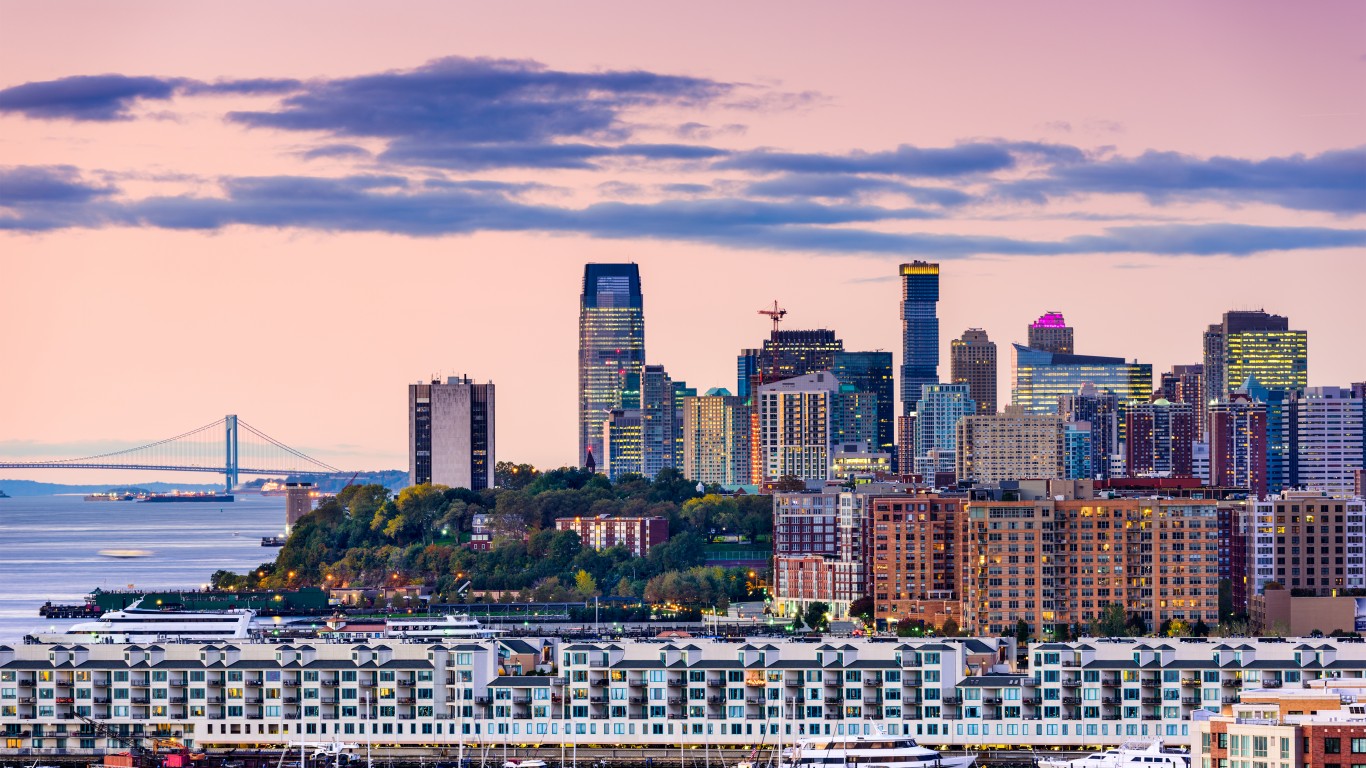
43. New Jersey
> Violent crime rate: 229 per 100,000
> Total 2017 murders: 324 (20th most)
> Imprisonment rate: 460 adults per 100,000 (7th lowest)
> Poverty rate: 10.0% (7th lowest)
> Most dangerous city: Camden
New Jersey is one of several states in the Northeast where violent crime is far less prevalent than it is across the country as a whole. There were just 229 incidents of violent crime per 100,000 state residents in 2017, well below the national violent crime rate of 394 per 100,000.
Not all parts of the state are safe, however. In cities like Asbury Park, Trenton, Atlantic City and Bridgeton, the violent crime rate exceeds 1,000 incidents per 100,000 people. In Camden, the violent crime rate falls just shy of 2,000 incidents per 100,000 people.
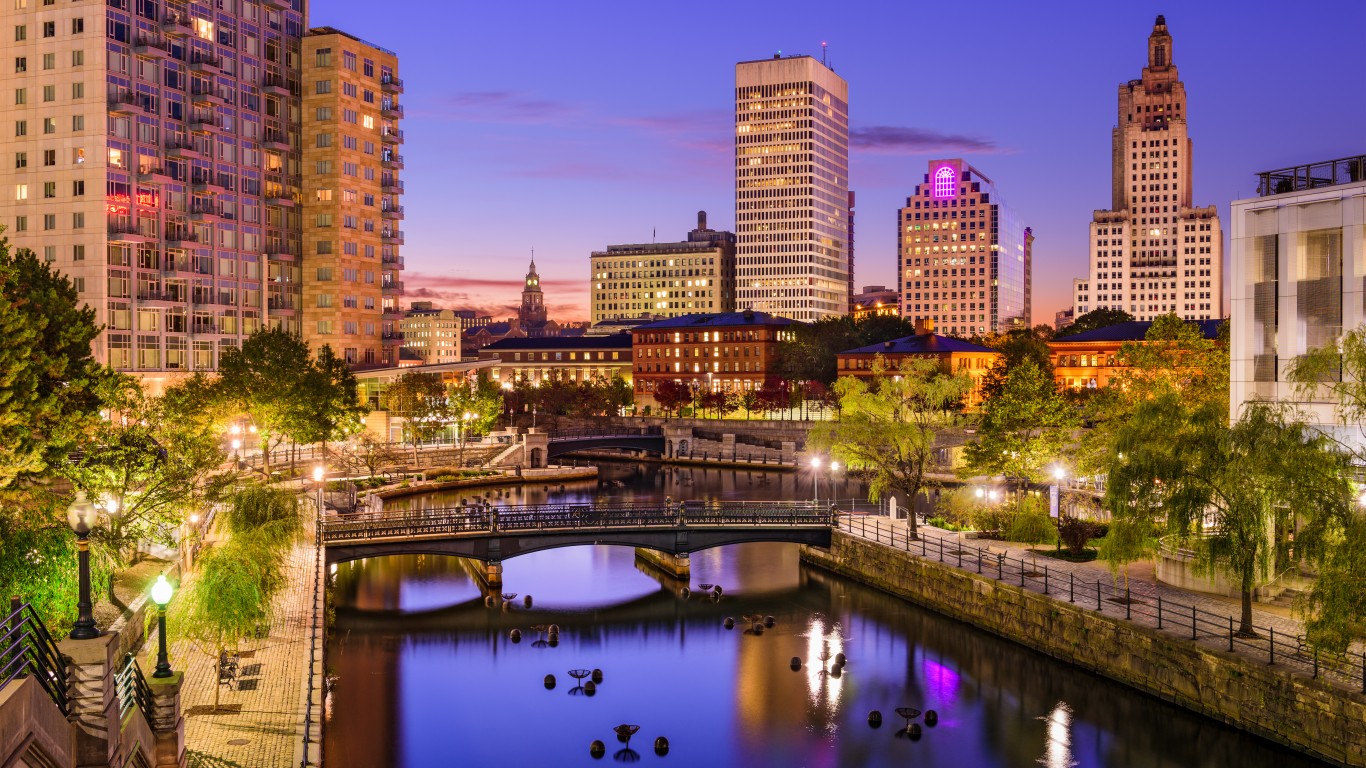
42. Rhode Island
> Violent crime rate: 232 per 100,000
> Total 2017 murders: 20 (5th fewest)
> Imprisonment rate: 370 adults per 100,000 (3rd lowest)
> Poverty rate: 11.6% (20th lowest)
> Most dangerous city: Providence
As one of the least populous states, Rhode Island has fewer total violent crimes than almost any state, and any drop can result in a large percentage point decline. From 2016 to 2017, the number of murders in the state dropped from 29 to 20, a 31% decline.
Rhode Island’s low violent crime rate of 232 incidents per 100,000 people may be one factor contributing to the state’s low incarceration rate. Just 370 in every 100,000 adults in Rhode Island are incarcerated, the third lowest incarceration rate of all states and well below the national incarceration rate of 850 per 100,000.
[in-text-ad-2]
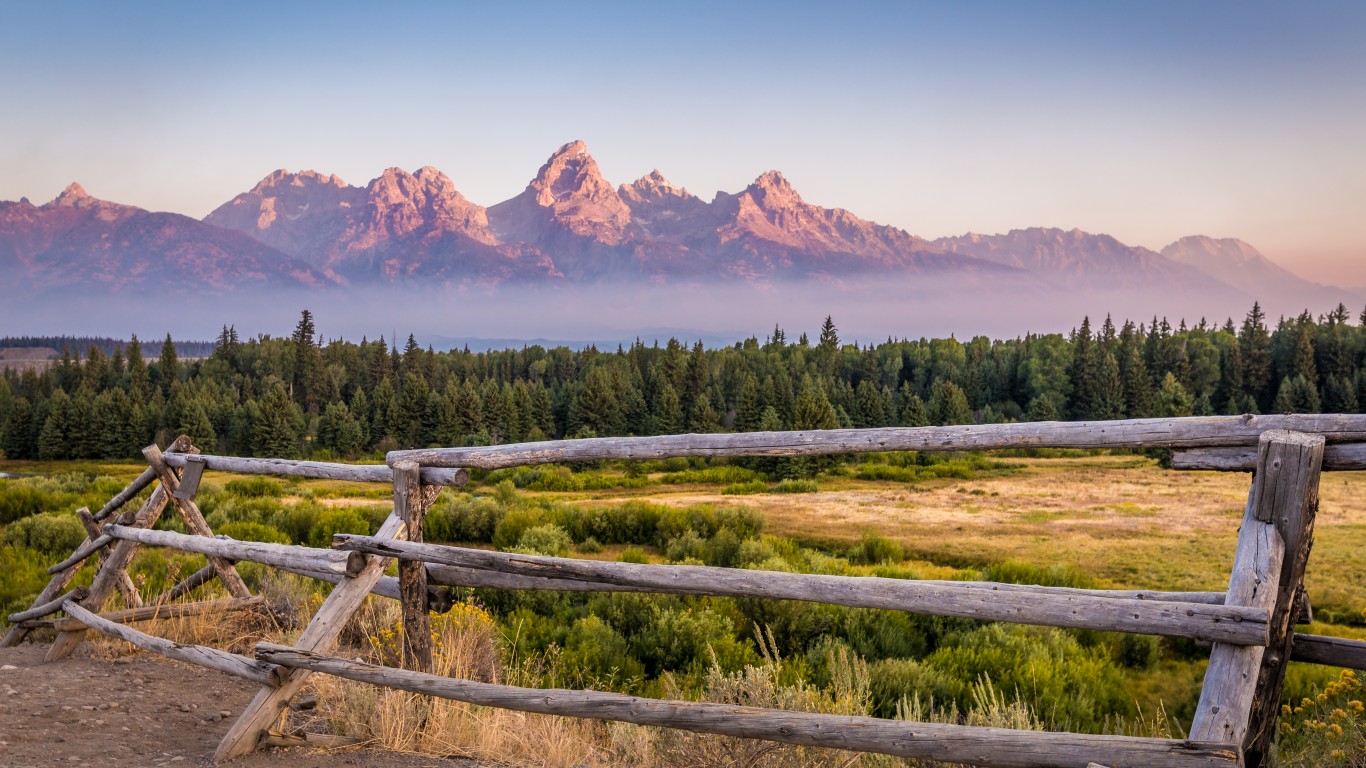
41. Wyoming
> Violent crime rate: 238 per 100,000
> Total 2017 murders: 15 (4th fewest)
> Imprisonment rate: 870 adults per 100,000 (19th highest)
> Poverty rate: 11.3% (19th lowest)
> Most dangerous city: Rock Springs
There were 1,376 violent crimes in Wyoming in 2017, the fewest of any state after only Vermont. Adjusted for the population, Wyoming’s violent crime rate of 238 incidents per 100,000 is the 10th lowest of any state.
Densely populated urban areas often report higher crime rates. Of the Wyoming cities home to at least 10,000 people, Rock Springs is the only one with a higher than average violent crime rate. There were 465 violent crimes per 100,000 people in Rock Springs in 2017, compared to the national violent crime rate of 394 per 100,000.

40. Minnesota
> Violent crime rate: 238 per 100,000
> Total 2017 murders: 113 (19th fewest)
> Imprisonment rate: 380 adults per 100,000 (5th lowest)
> Poverty rate: 9.5% (4th lowest)
> Most dangerous city: Minneapolis
The Minnesota violent crime rate fell by 1.5% from 2016 to 2017, slightly outpacing the U.S. decline in violent crime rate of 0.9% over the same time period. The drop was largely due to declines in the two most common violent crimes — robbery and aggravated assault. The robbery rate dropped by 3.9% and the aggravated assault rate fell 1.1%.
However, Minnesota had one of the larger murder rate increases during that time, with an 11.1% jump from the year before. Still, Minnesota’s murder rate of 2.0 per 100,000 residents is the sixth lowest of any state.
[in-text-ad]
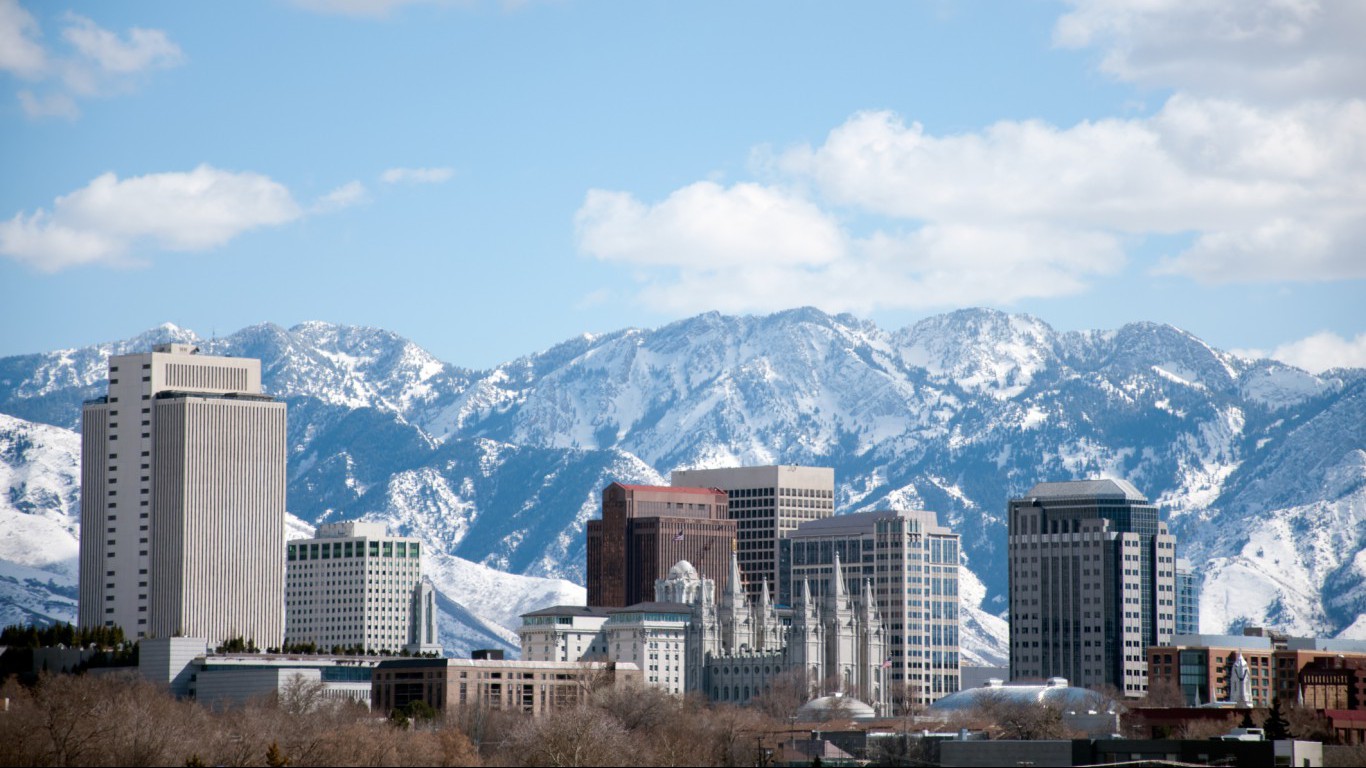
39. Utah
> Violent crime rate: 239 per 100,000
> Total 2017 murders: 73 (14th fewest)
> Imprisonment rate: 540 adults per 100,000 (13th lowest)
> Poverty rate: 9.7% (6th lowest)
> Most dangerous city: South Salt Lake
One of the safest states in the country, Utah is also safer now than it was a year ago. There were 239 violent crimes in Utah for every 100,000 people in 2017, a 1.8% improvement from the state’s 2016 violent crime rate of 243 incidents per 100,000.
Violence in Utah is largely concentrated in major cities. In South Salt Lake and Salt Lake proper, there were 947 and 879 violent crimes per 100,000 people, respectively, the highest violent crime rates of any city with at least 10,000 residents in the state.

38. Hawaii
> Violent crime rate: 251 per 100,000
> Total 2017 murders: 39 (9th fewest)
> Imprisonment rate: 500 adults per 100,000 (9th lowest)
> Poverty rate: 9.5% (4th lowest)
> Most dangerous city: Honolulu
Though Hawaii does not rank among the 10 safest states, its violent crime rate of 251 incidents per 100,000 is well below the national violent crime rate of 394 per 100,000.
Nationwide, the violent crime rate dipped by 0.9% from 2016 to 2017. Hawaii represents a break from the national trend as the incidence of violent crime ticked up 3.7% over the same period, one of the largest increases of any state. Climbing robbery and aggravated assault rates largely drove the increase.
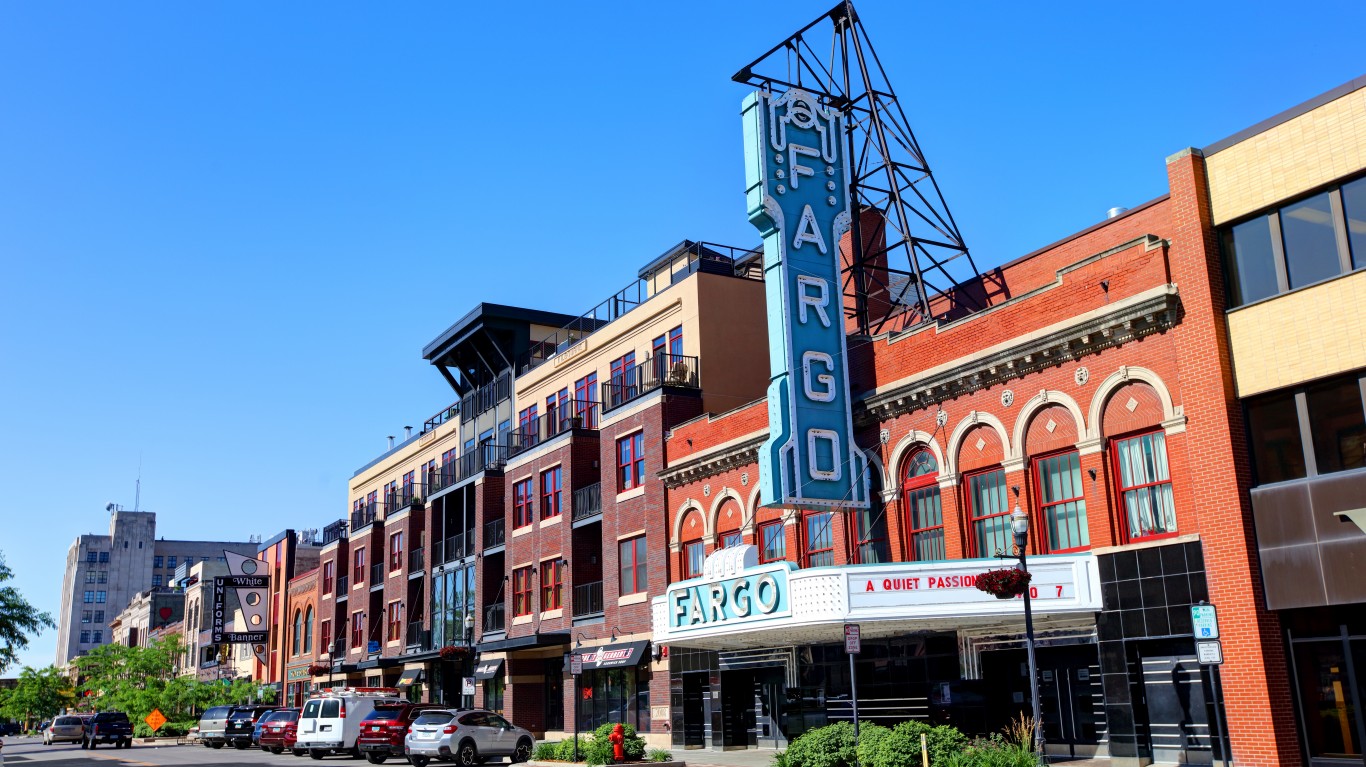
37. North Dakota
> Violent crime rate: 281 per 100,000
> Total 2017 murders: 10 (the fewest)
> Imprisonment rate: 540 adults per 100,000 (13th lowest)
> Poverty rate: 10.3% (9th lowest)
> Most dangerous city: Fargo
North Dakota has the second lowest murder rate of U.S. states, at 1.3 homicides per 100,000 residents. There were only 10 murders in North Dakota in 2017, down 37.5% from 16 the year before, the largest decline of any state.
However, the state’s overall violent crime rate increased by 11.6%. Only two other states had a greater overall increase in violent crimes. This is largely due to a spike in aggravated assault. While still a relatively low rate, North Dakota’s aggravated assault rate of 203 per 100,000 residents in 2017 represents a 13.4% increase from 2016.
[in-text-ad-2]

36. Oregon
> Violent crime rate: 282 per 100,000
> Total 2017 murders: 104 (18th fewest)
> Imprisonment rate: 640 adults per 100,000 (18th lowest)
> Poverty rate: 13.2% (23rd highest)
> Most dangerous city: Portland
Oregon is the safest state along the Pacific coast. There were 282 violent crimes for every 100,000 residents in the state in 2017 — compared to over 300 per 100,000 in Washington state and over 440 per 100,000 in California.
Crime appears to be on the rise in Oregon, however. Last year, the number of robberies, rapes, aggravated assaults all increased. In total, the rise in violent crimes outpaced population growth, resulting in a 4.8% increase in the violent crime rate from 2016 to 2017.
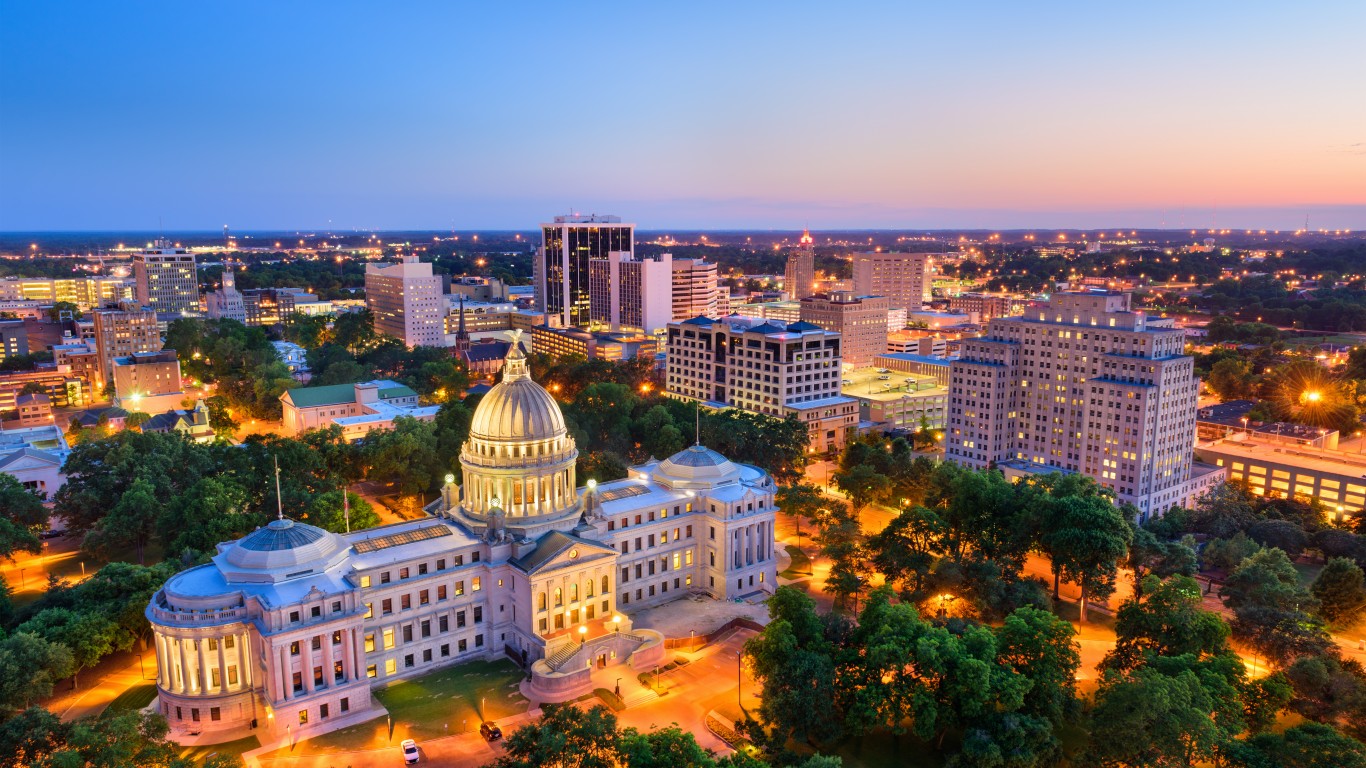
35. Mississippi
> Violent crime rate: 286 per 100,000
> Total 2017 murders: 245 (24th most)
> Imprisonment rate: 1,260 adults per 100,000 (3rd highest)
> Poverty rate: 19.8% (the highest)
> Most dangerous city: Greenwood
Mississippi’s violent crime rate of 286 reported incidents per 100,000 residents is well below the U.S. violent crime rate of 394 per 100,000. Mississippi is far safer than other states in the region. Not only is the state’s violent crime rate lower than most U.S. states, but also each of Mississippi’s bordering states — Alabama, Arkansas, Tennessee, and Louisiana — each have some of the highest violent crime rates in the country.
Despite a low overall violent crime rate, Mississippi has the eighth highest murder rate in the country, at 8.2 per 100,000.
[in-text-ad]
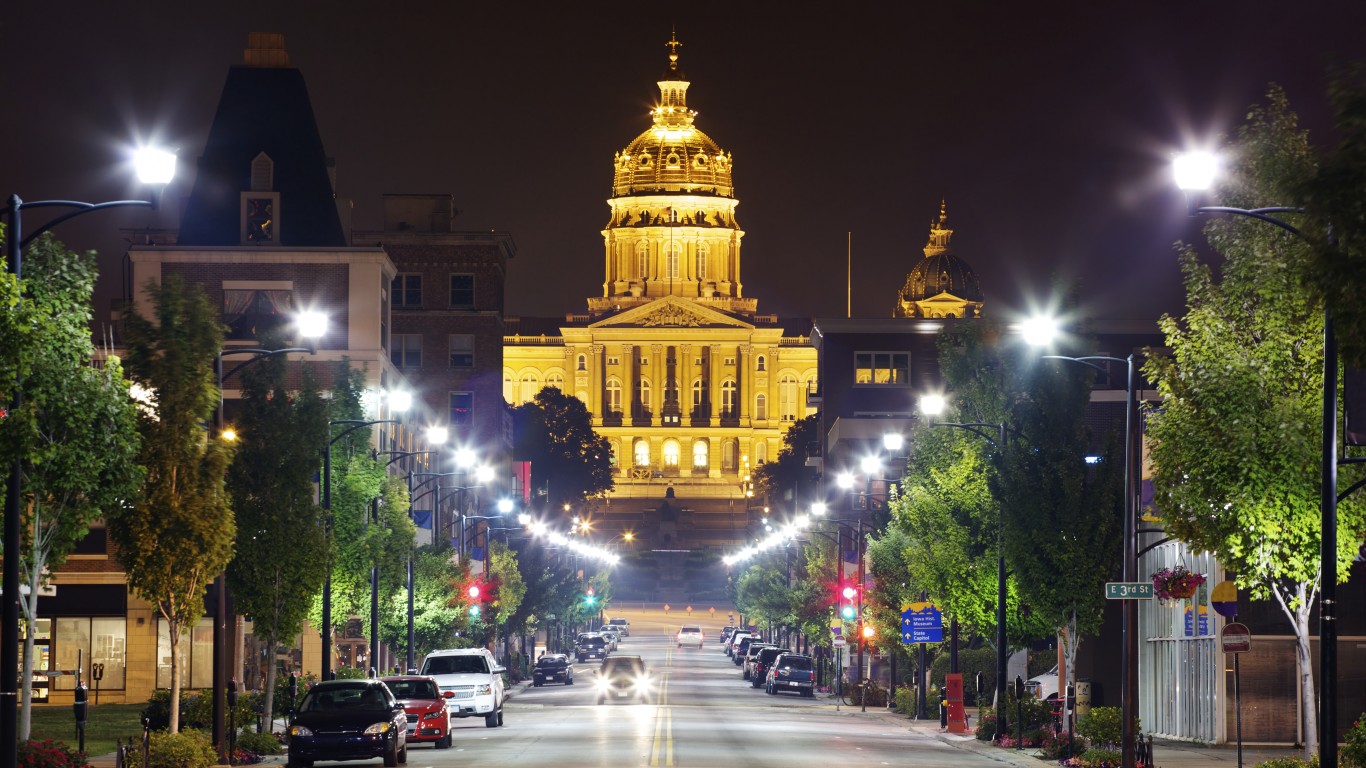
34. Iowa
> Violent crime rate: 293 per 100,000
> Total 2017 murders: 104 (18th fewest)
> Imprisonment rate: 560 adults per 100,000 (14th lowest)
> Poverty rate: 10.7% (12th lowest)
> Most dangerous city: Clinton
Iowa is one of many Midwestern states that are far safer than the nation as a whole. There were just 293 violent crimes for every 100,000 state residents in 2017, compared to 394 per 100,000 nationwide.
Despite ranking as a safer place than most states, Iowa reported a substantial spike in murders and non-negligent homicides in 2017. There were 104 murders in the state last year, a nation-leading jump of 42.5% from the 73 murders reported the previous year.
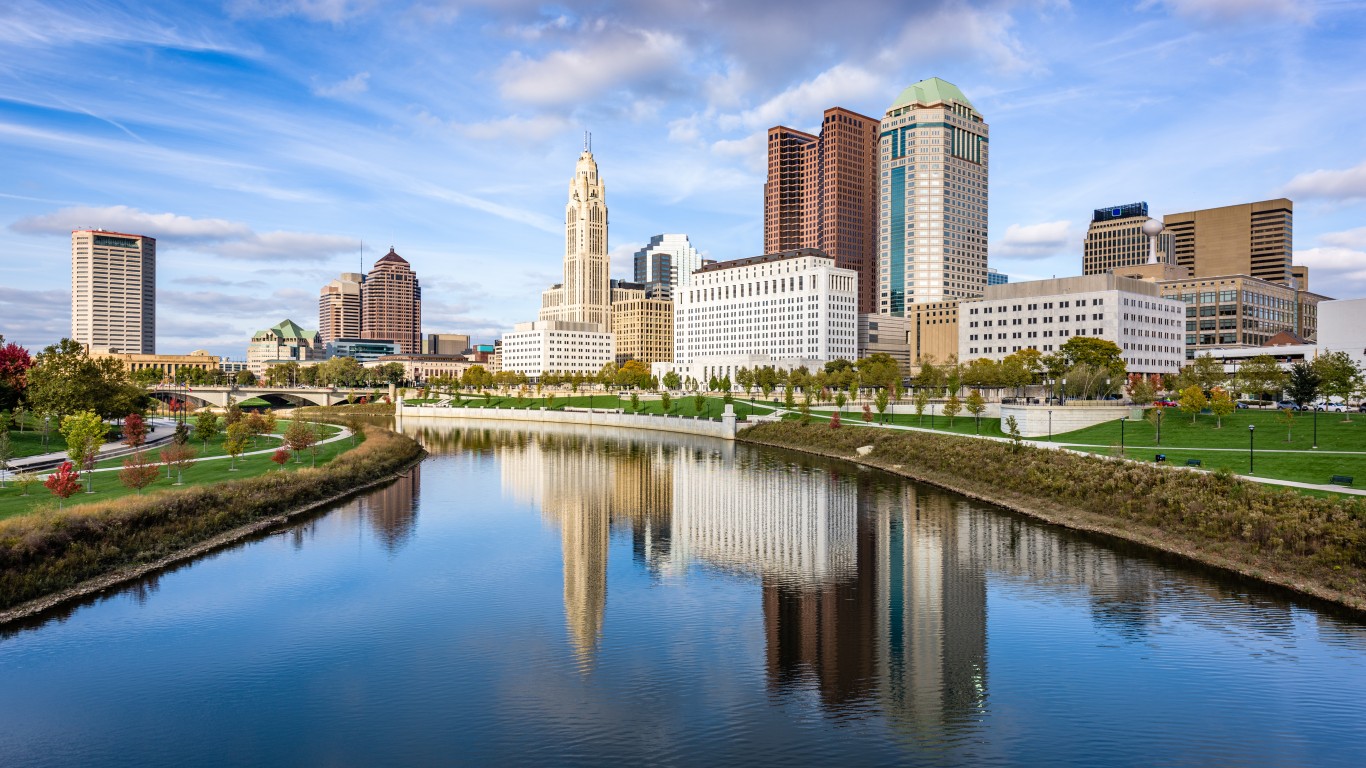
33. Ohio
> Violent crime rate: 298 per 100,000
> Total 2017 murders: 710 (6th most)
> Imprisonment rate: 790 adults per 100,000 (24th highest)
> Poverty rate: 14.0% (17th highest)
> Most dangerous city: Cleveland
Aggravated assault is the most common type of violent crime in both Ohio, and the nation as a whole. Still, such crimes are less common in Ohio than in much of the rest of the country. The state’s assault rate of 142 reported incidents per 100,000 people is well below the U.S. rate of 249 aggravated assault per 100,000 Americans.
The low rate of assault is the reason why Ohio has a relatively low violent crime rate. The other types of violent crimes — murder, rape, and robbery — all happen more frequently in Ohio than they do in the United States as a whole.

32. Washington
> Violent crime rate: 305 per 100,000
> Total 2017 murders: 230 (25th fewest)
> Imprisonment rate: 530 adults per 100,000 (11th lowest)
> Poverty rate: 11.0% (14th lowest)
> Most dangerous city: Fife
With lower than average rates of murder, robbery, and aggravated assault, Washington is one of the safer states in the country. However, the state’s violent crime rate increased slightly over the past year, rising 0.3% from 2016 to 2017.
States with lower violent crime rates also tend to have lower property crime rates, but that is not the case in Washington. There were 3,174 property crimes — which includes larceny, burglary, and motor vehicle theft — reported per 100,000 Washington residents in 2017, the fifth most of any state.
[in-text-ad-2]
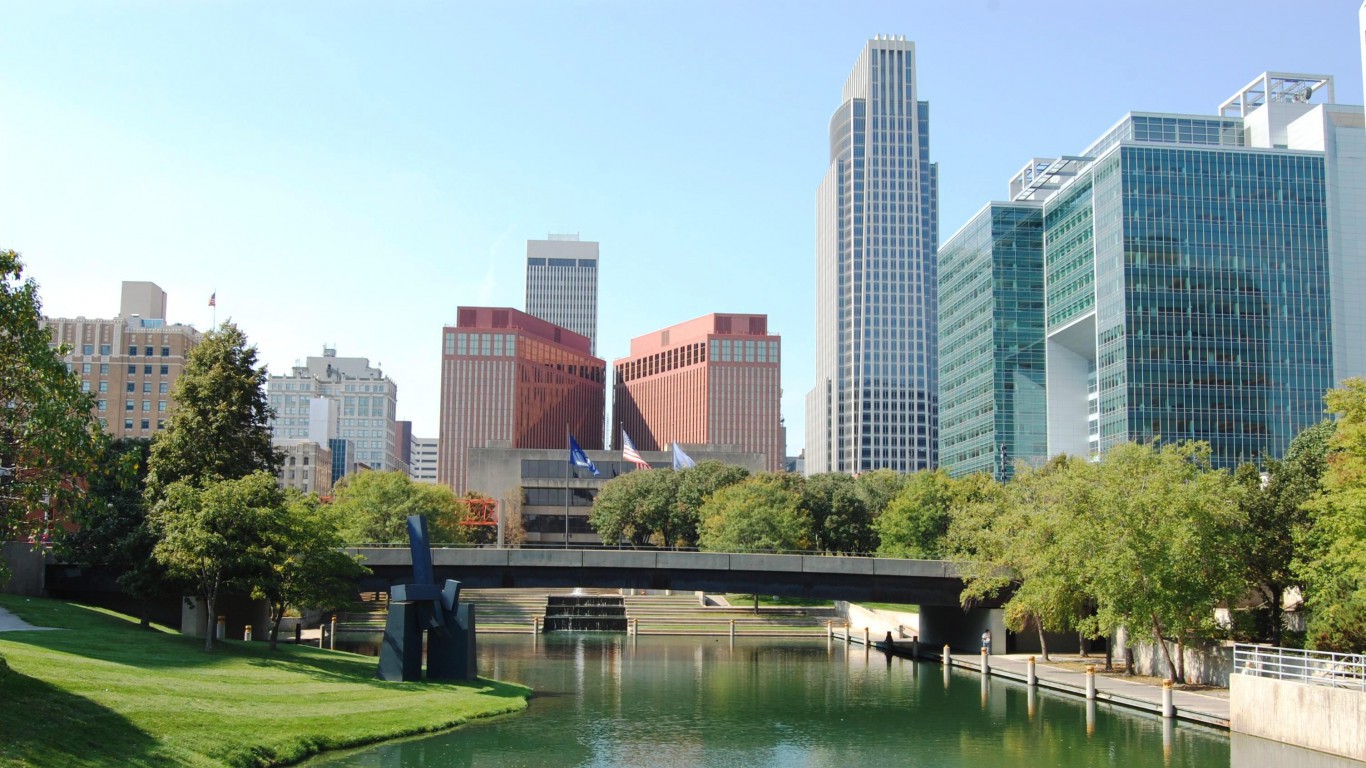
31. Nebraska
> Violent crime rate: 306 per 100,000
> Total 2017 murders: 43 (11th fewest)
> Imprisonment rate: 610 adults per 100,000 (16th lowest)
> Poverty rate: 10.8% (13th lowest)
> Most dangerous city: Omaha
The Midwest is home to about 21% of the U.S. population and accounts for about 20% of all violent crime. Nebraska is one of the safer states in the region, reporting 306 incidents of violent crime for every 100,000 residents.
Crime in Nebraska is heavily concentrated in Omaha, the largest city in the state. There were 2,909 violent crimes in Omaha in 2017, about half of the 5,873 total incidents statewide that year.

30. Pennsylvania
> Violent crime rate: 313 per 100,000
> Total 2017 murders: 739 (5th most)
> Imprisonment rate: 810 adults per 100,000 (22nd highest)
> Poverty rate: 12.5% (23rd lowest)
> Most dangerous city: McKeesport
Home to 17.3% of the U.S. population and accounting for just 13.4% of all violent crime nationwide, the Northeast is the safest region in the United States. One of the most populous states in the region is Pennsylvania, and the state’s violent crime rate of 313 incidents per 100,000 is considerably lower than the national rate of 394 violent crimes per 100,000 Americans.
Not all parts of the state are safe, however. In cities like Chester, Darby, York, and the state capital of Harrisburg, there were more than 1,000 violent crimes for every 100,000 residents in 2017. In McKeesport, just southeast of Pittsburgh, the violent crime rate exceeds 2,000 incidents per 100,000 people.
[in-text-ad]

29. Wisconsin
> Violent crime rate: 320 per 100,000
> Total 2017 murders: 186 (23rd fewest)
> Imprisonment rate: 790 adults per 100,000 (24th highest)
> Poverty rate: 11.3% (19th lowest)
> Most dangerous city: Milwaukee
As its position on the list suggests, Wisconsin is safer than the average U.S. state but not by a significant amount. The state has slightly lower rates of murder, rape, robbery, and aggravated assault than the United States as a whole.
From 2016 to 2017, Wisconsin’s violent crime rate increased by 4.2% to 320 reported incidents per 100,000 people, one of the greatest increases of any state. The increase was largely driven by a 10% surge in the rate of aggravated assault.

28. West Virginia
> Violent crime rate: 351 per 100,000
> Total 2017 murders: 85 (15th fewest)
> Imprisonment rate: 690 adults per 100,000 (21st lowest)
> Poverty rate: 19.1% (4th highest)
> Most dangerous city: Wheeling
No state reported a steeper decline in the number of robberies from 2016 to 2017 than West Virginia, at 27.2%. Robbery is a component of the violent crime rate, and the incidence of violence dropped from 363 incidents per 100,000 people to 351 per 100,000 over the same period.
Crime is often concentrated in densely populated urban areas, and in West Virginia, both the state capital of Charleston and the former state capital of Wheeling recorded violent crime rates above 1,000 incidents per 100,000 people in 2017.

27. New York
> Violent crime rate: 357 per 100,000
> Total 2017 murders: 548 (12th most)
> Imprisonment rate: 480 adults per 100,000 (8th lowest)
> Poverty rate: 14.1% (16th highest)
> Most dangerous city: Newburgh
New York is the second most dangerous state in the Northeast, trailing only Massachusetts. Still, violent crime rates are falling in the Empire State. There were 70,799 incidents of violent crime in the state in 2017, down from 74,315 in 2016. The state’s violent crime rate of 357 incidents per 100,000 represents a 4.8% improvement from the previous year.
Crime is heavily concentrated in a handful of New York cities. Both Buffalo and Niagara Falls in western New York have a violent crime rate over 2.5 times the 394 per 100,000 national rate. Newburgh, located about 60 miles north of Manhattan has the highest violent crime rate of any city home to at least 10,000 in the state, at 1,236 per 100,000 — more than triple the national rate.
[in-text-ad-2]
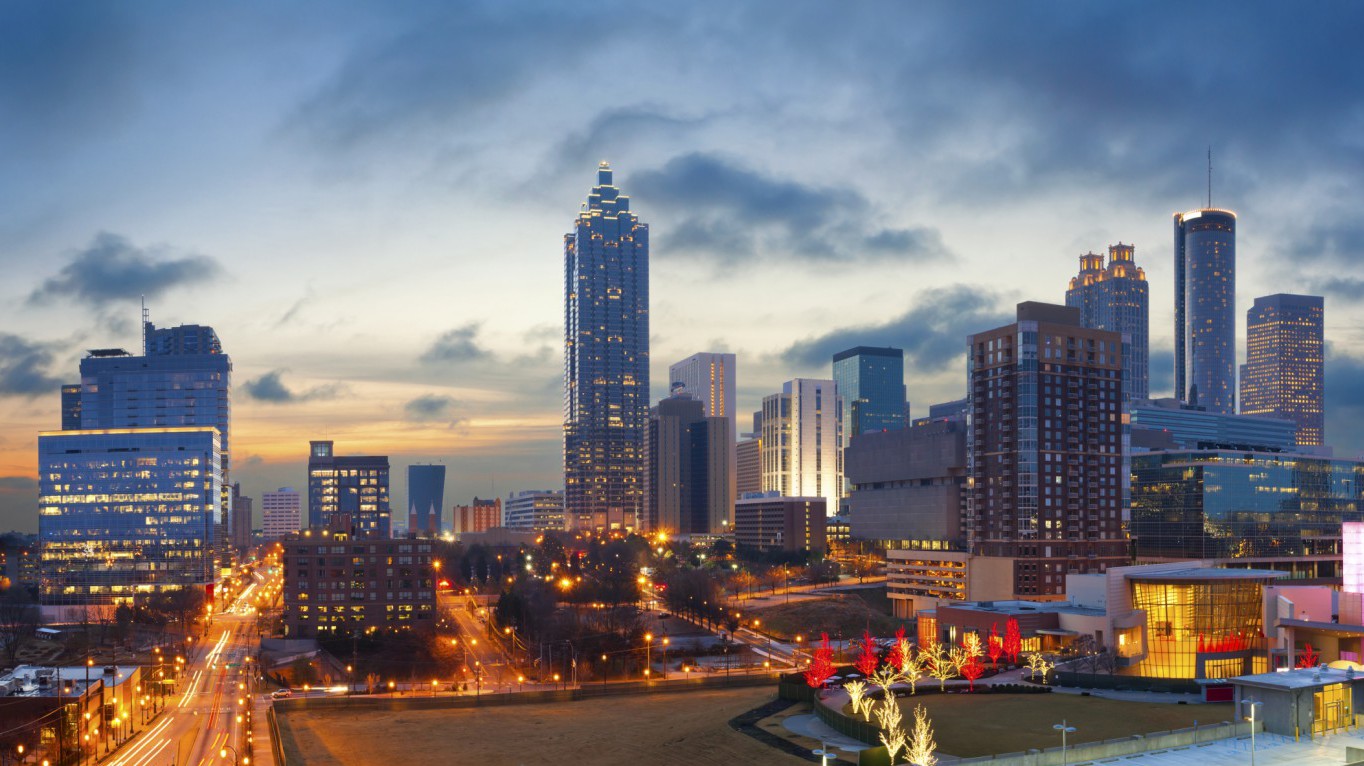
26. Georgia
> Violent crime rate: 357 per 100,000
> Total 2017 murders: 703 (7th most)
> Imprisonment rate: 1,160 adults per 100,000 (4th highest)
> Poverty rate: 14.9% (11th highest)
> Most dangerous city: College Park
Georgia’s violent crime rate of 357 reported incidents per 100,000 residents is slightly below the U.S. violent crime rate. From 2016 to 2017, the state’s violent crime rate dropped by 8.5%, the third largest decline among states. A 20.4% drop in the rate of rape and an 18.0% decrease in the rate of robbery contributed to the overall decline.
Though Georgia’s violent crime rate is lower than the national rate, a relatively large share of adult residents are in prison. For every 100,000 adults living in Georgia, 1,160 are incarcerated. According to the Georgia Department of Corrections, 54.4% of inmates admitted in 2017 are serving a sentence of more than nine years.
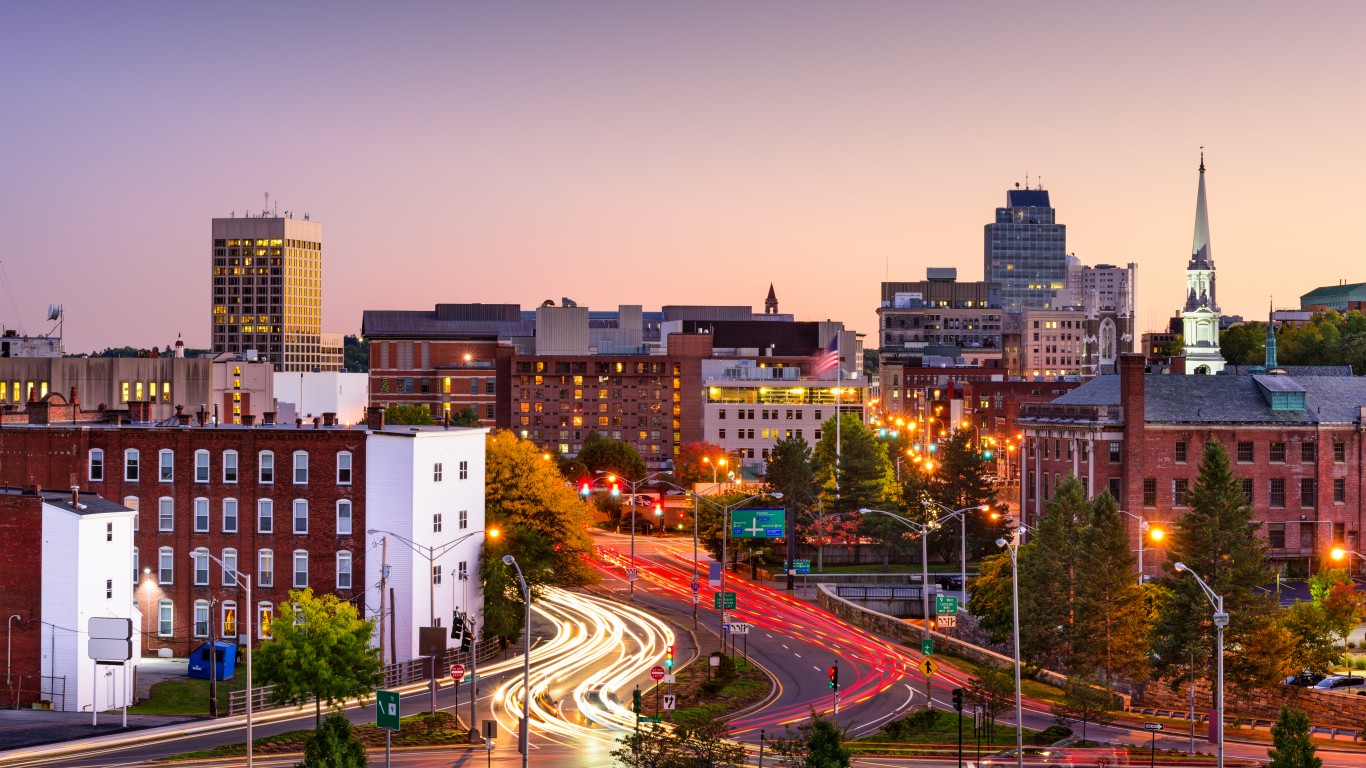
25. Massachusetts
> Violent crime rate: 358 per 100,000
> Total 2017 murders: 173 (22nd fewest)
> Imprisonment rate: 360 adults per 100,000 (2nd lowest)
> Poverty rate: 10.5% (10th lowest)
> Most dangerous city: North Adams
Massachusetts is the most dangerous state in the Northeast. Still, the state’s violent crime rate was lower than the nationwide rate in 2017, at 358 violent crimes for every 100,000 Massachusetts residents compared to 394 per 100,000 nationwide. Despite a growing population, there were about 1,400 fewer violent crimes in Massachusetts in 2017, 5.4% fewer than the year before.
North Adams and Holyoke are the only two cities with populations of at least 10,000 in the state with violent crime rates exceeding 1,000 incidents per 100,000 people.
[in-text-ad]
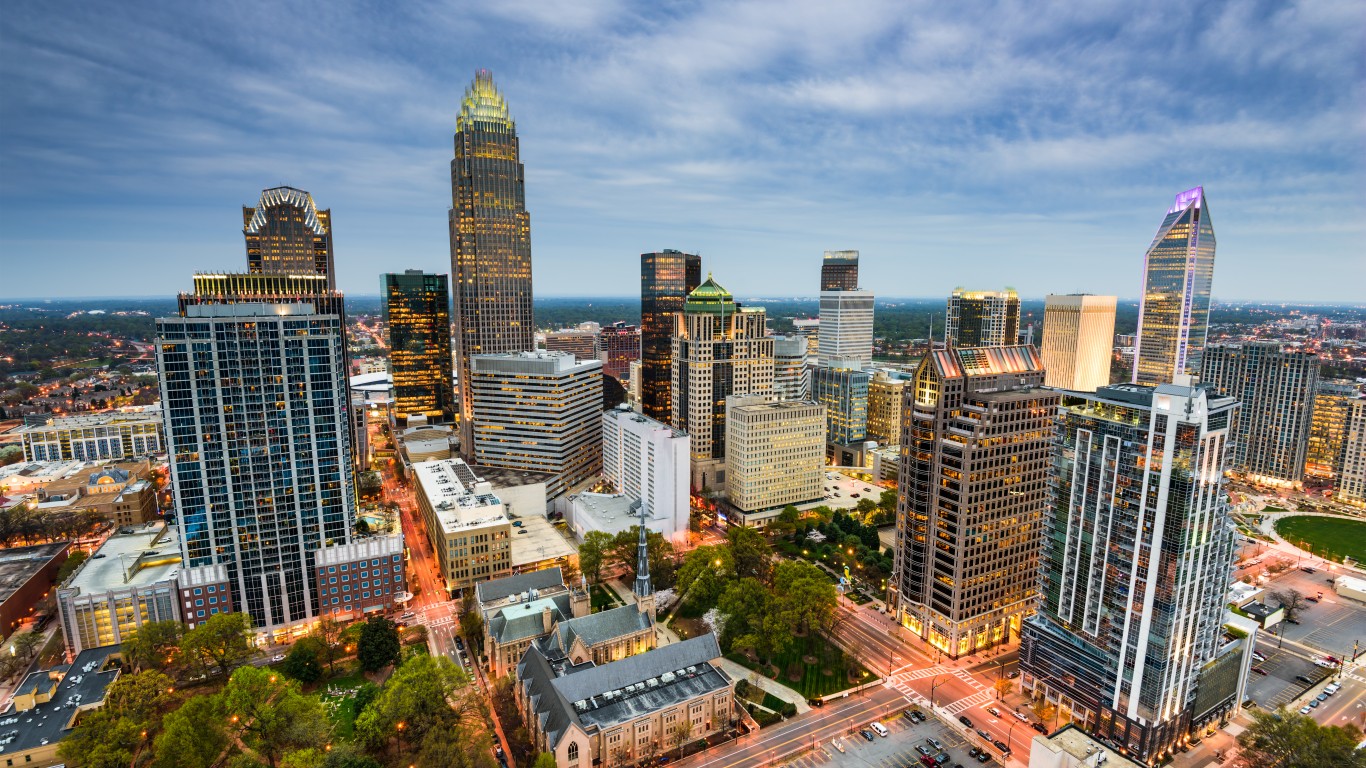
24. North Carolina
> Violent crime rate: 364 per 100,000
> Total 2017 murders: 591 (9th most)
> Imprisonment rate: 680 adults per 100,000 (20th lowest)
> Poverty rate: 14.7% (13th highest)
> Most dangerous city: Kinston
Though North Carolina’s violent crime rate of 364 per 100,000 is higher than that of most U.S. states, it is below the nationwide violent crime rate of 394 per 100,000. With the exception of robbery, the incidence of every type of violent crime fell more in North Carolina than it did nationwide from 2016 to 2017, resulting in a 2.2% drop in the state’s overall violent crime rate.
Kinston and Henderson are the only two cities in the state with a population of 10,000 or more where the violent crime rate exceeds 1,000 incidents per 100,000 people.

23. Colorado
> Violent crime rate: 368 per 100,000
> Total 2017 murders: 221 (24th fewest)
> Imprisonment rate: 740 adults per 100,000 (24th lowest)
> Poverty rate: 10.3% (9th lowest)
> Most dangerous city: Pueblo
Home to 23.8% of the U.S. population, but accounting for 25.5% of all violent crime, the Western U.S. is slightly more dangerous than other parts of the country. Still, Colorado’s violent crime rate of 368 incidents per 100,000 people is below the national violent crime rate of 394 per 100,000.
One of the fastest growing states in the country, Colorado also has a rapidly climbing violent crime rate. The state’s violent crime rate is 7% higher than it was in 2016, when there were 344 incidents per 100,000 people.
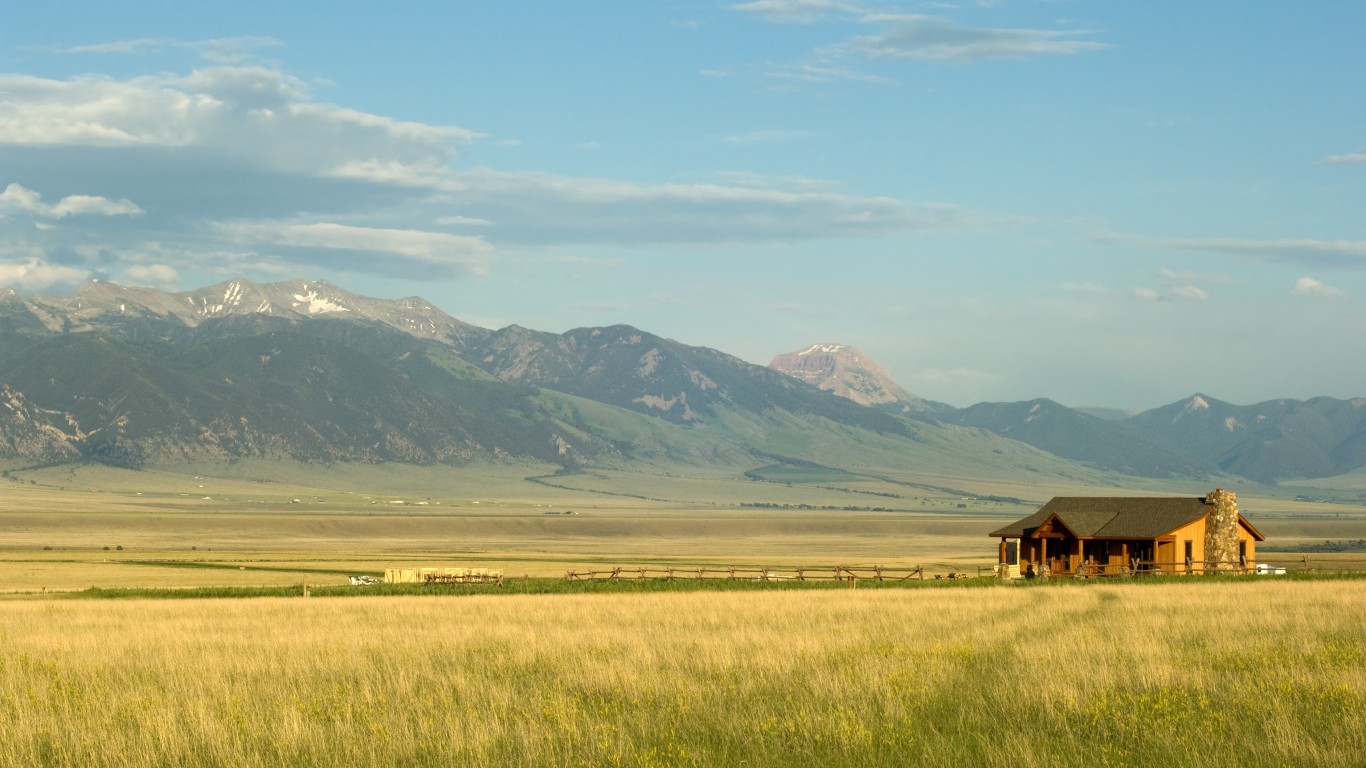
22. Montana
> Violent crime rate: 377 per 100,000
> Total 2017 murders: 41 (10th fewest)
> Imprisonment rate: 700 adults per 100,000 (22nd lowest)
> Poverty rate: 12.5% (23rd lowest)
> Most dangerous city: Helena
Montana’s violent crime rate of 377 reported incidents per 100,000 residents is just slightly below the U.S. violent crime rate of 394 per 100,000. Like nearly every other state, most violent crimes committed in Montana are aggravated assaults. The state’s aggravated assault rate of 287 per 100,000 people is higher than the nationwide rate.
However, Montana also has a very low rate of robbery. There were 28 robberies reported per 100,000 state residents in 2017, the seventh lowest rate of any state. For context, the U.S. robbery rate is 98 robberies per 100,000 residents.
[in-text-ad-2]
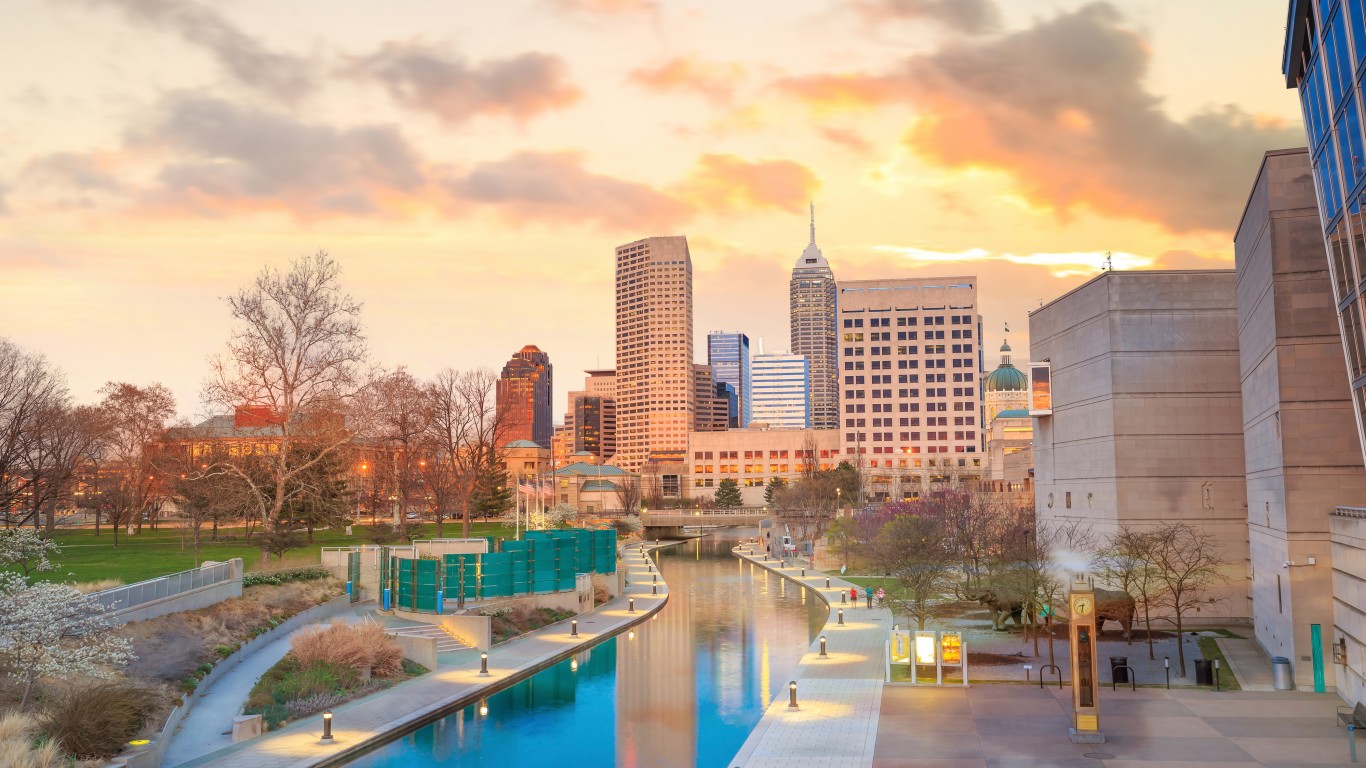
21. Indiana
> Violent crime rate: 399 per 100,000
> Total 2017 murders: 397 (18th most)
> Imprisonment rate: 850 adults per 100,000 (20th highest)
> Poverty rate: 13.5% (20th highest)
> Most dangerous city: Indianapolis
Though violent crime is slightly less common in the Midwest than it is across the country as a whole, Indiana is an exception. Due in no small part to high crime rates in cities like Indianapolis and South Bend, Indiana’s violent crime rate of 399 incidents per 100,000 people is slightly higher than the national violent crime rate of 394 per 100,000. Nearly 40% of the 397 murders in the state in 2017 were committed in Indianapolis.

20. Florida
> Violent crime rate: 408 per 100,000
> Total 2017 murders: 1,057 (3rd most)
> Imprisonment rate: 900 adults per 100,000 (13th highest)
> Poverty rate: 14.0% (17th highest)
> Most dangerous city: Florida City
Florida has lower rates of rape, murder, and robbery than the United States as a whole. Yet its violent crime rate of 408 incidents per 100,000 people is one of the higher rates among states. What drives Florida’s violent crime rate is the state’s relatively high rate of aggravated assault. There were 277 reported incidents for every 100,000 Florida residents in 2017, more than the national aggravated assault rate of 249 per 100,000 Americans.
Located approximately 25 miles south of downtown Miami, Florida City is the most dangerous city in Florida and one of the most dangerous cities in the nation. There were 2,276 violent crimes reported per 100,000 Florida City residents in 2017, the sixth most of any U.S. city with at least 10,000 residents.
[in-text-ad]
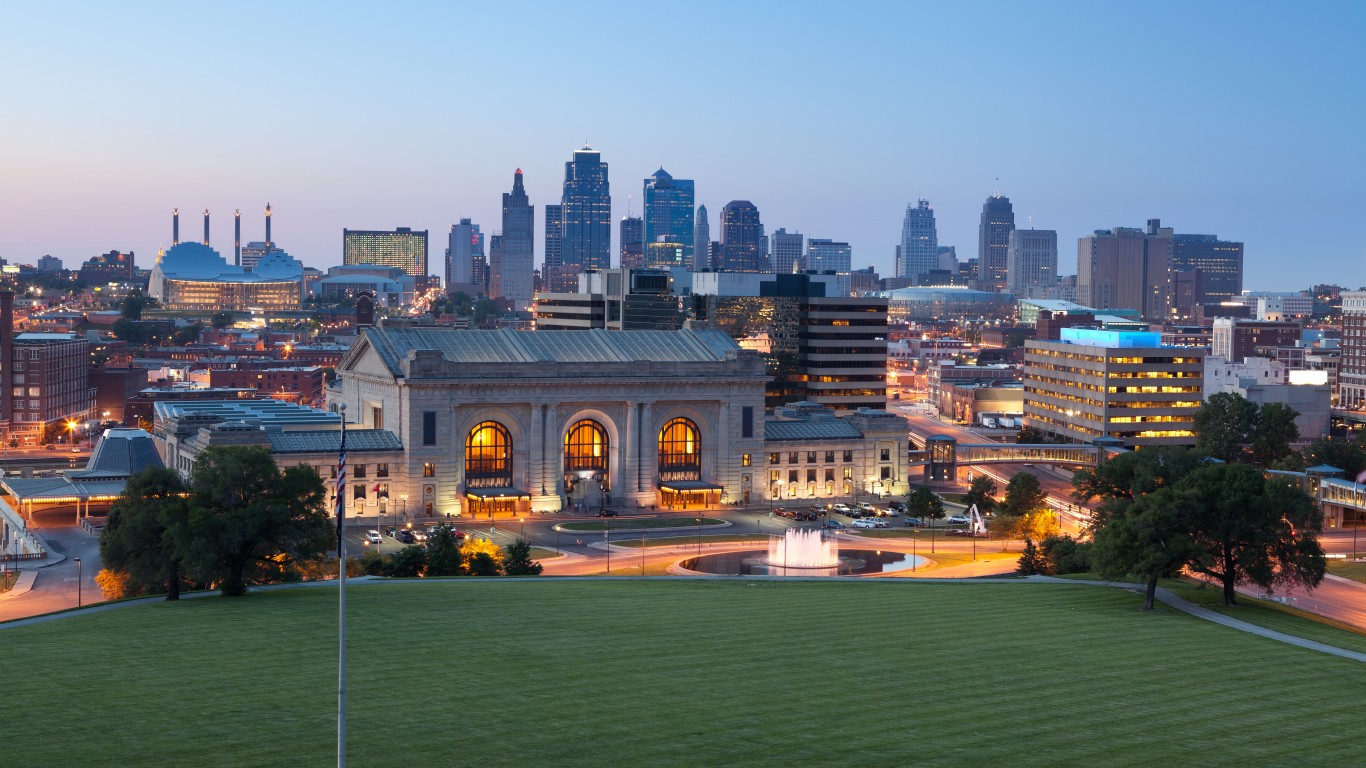
19. Kansas
> Violent crime rate: 413 per 100,000
> Total 2017 murders: 160 (21st fewest)
> Imprisonment rate: 780 adults per 100,000 (25th lowest)
> Poverty rate: 11.9% (21st lowest)
> Most dangerous city: Wichita
There were 413 violent crimes in Kansas for every 100,000 people in 2017, a higher violent crime rate than in most states and the United States as a whole.
Kansas reported a 21.2% surge in homicide in 2017, one of the largest increases of any state. There were 5.5 murders for every 100,000 people in the state in 2017, compared to 5.3 per 100,000 nationwide. In 2016, the state’s murder rate was 4.5 per 100,000, well below the national murder rate that year of 5.4 per 100,000.

18. South Dakota
> Violent crime rate: 434 per 100,000
> Total 2017 murders: 25 (7th fewest)
> Imprisonment rate: 880 adults per 100,000 (16th highest)
> Poverty rate: 13.0% (24th highest)
> Most dangerous city: Rapid City
There were 434 violent crimes in South Dakota in 2017, a higher rate than the national violent crime rate of 394 per 100,000 and considerably more than the rate in North Dakota of 281 incidents per 100,000 residents. One-third of the 3,771 violent crimes in the state in 2017 were reported in either Rapid City or Sioux Falls, South Dakota’s two largest cities. In Rapid City there were a total of 640 violent crimes per 100,000 residents, the most of any city in South Dakota with a population of at least 10,000.

17. Illinois
> Violent crime rate: 439 per 100,000
> Total 2017 murders: 997 (4th most)
> Imprisonment rate: 620 adults per 100,000 (17th lowest)
> Poverty rate: 12.6% (24th lowest)
> Most dangerous city: East St. Louis
Illinois had 997 murders in 2017, the fourth most of any state. Nearly two-thirds of those murders were committed in Chicago, the largest city in the state. Overall, the state’s murder rate was ninth highest, at 7.8 homicides for every 100,000 state residents of the state.
Though Chicago’s murder rate is often in the news, another Illinois city, East St. Louis, has the highest murder rate in the country. There were 111 murders for every 100,000 East St. Louis residents in 2017. The next highest murder rate is in Chester, Pennsylvania, with 85 per 100,000.
[in-text-ad-2]

16. Texas
> Violent crime rate: 439 per 100,000
> Total 2017 murders: 1,412 (2nd most)
> Imprisonment rate: 1,050 adults per 100,000 (6th highest)
> Poverty rate: 14.7% (13th highest)
> Most dangerous city: Bellmead
There were 439 violent crimes reported per 100,000 Texas residents in 2017, far more than the national rate of 394 incidents per 100,000 Americans. While the Lone Star States surpassed the U.S. in rates of rape, robbery, and aggravated assault, Texas has a lower homicide rate than the country as a whole. There were 5.0 murders reported per 100,000 Texas residents in 2017, compared to the national rate of 5.3 murders per 100,000 Americans.
Texas is home to one of the most dangerous cities in the country. In Bellmead, a city several miles northeast of Waco, there were 2,305 violent crimes reported per 100,000 people in 2017 — the most of any city with a population of at least 10,000 in Texas and the fifth most of any city nationwide.

15. California
> Violent crime rate: 449 per 100,000
> Total 2017 murders: 1,830 (the most)
> Imprisonment rate: 670 adults per 100,000 (19th lowest)
> Poverty rate: 13.3% (22nd highest)
> Most dangerous city: Susanville
There were more violent crimes committed in California in 2017 than in any other state. California is by far the most populous state in the country, and law enforcement agencies across the state recorded 177,627 violent crimes last year, about 14% of the total number recorded nationwide.
Even when adjusted for the population, the state’s violent crime rate, at 449 incidents per 100,000 people, is slightly higher than the average nationwide. Robberies are especially common in California. There were 143 robberies per 100,000 state residents in 2017, a higher rate than in all but three other states.
[in-text-ad]
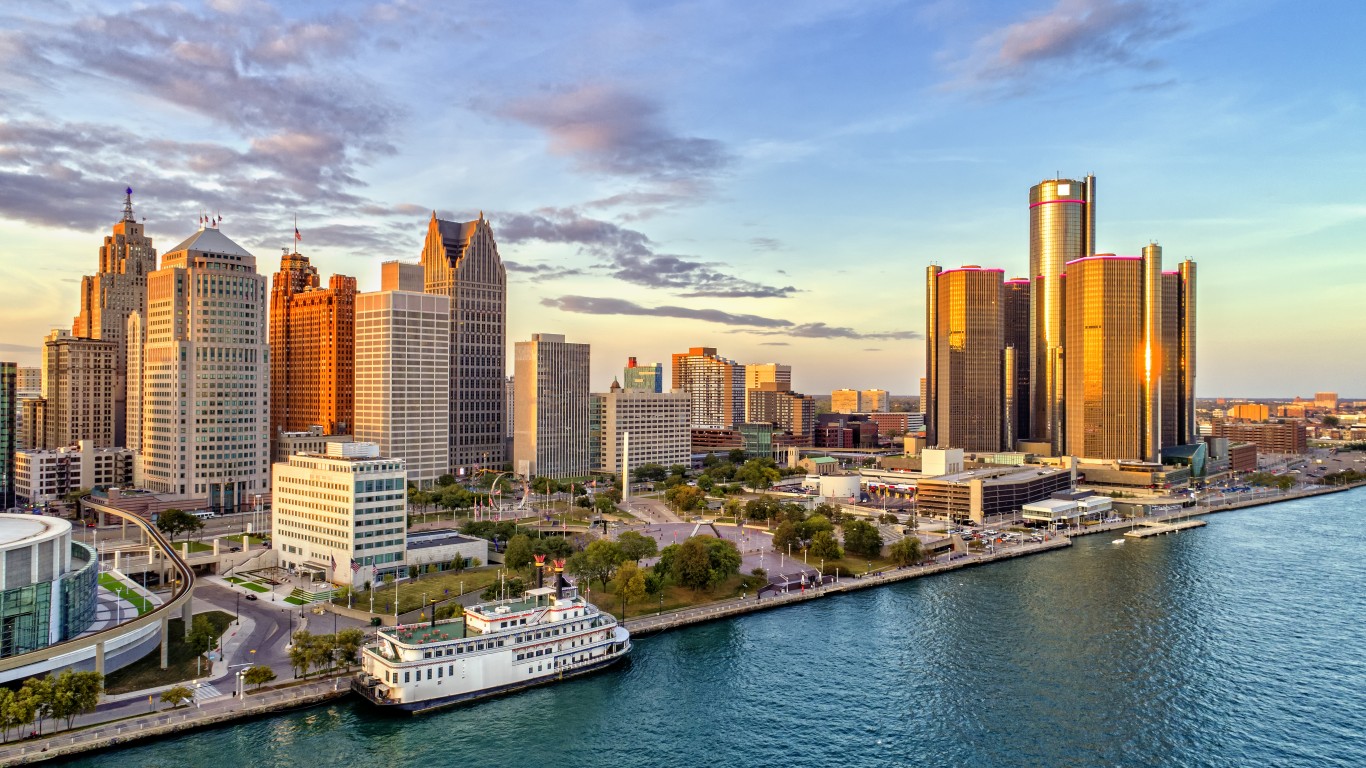
14. Michigan
> Violent crime rate: 450 per 100,000
> Total 2017 murders: 569 (11th most)
> Imprisonment rate: 730 adults per 100,000 (23rd lowest)
> Poverty rate: 14.2% (15th highest)
> Most dangerous city: Detroit
There were 450 violent crimes reported per 100,000 residents in Michigan in 2017, far more than the national rate of 394 incidents per 100,000 Americans and among the most of any state. One factor contributing to the high crime rate in Michigan is the high incidence of rape. There were 7,301 rapes reported in Michigan in 2017, the second most of any state when adjusted for the population.
While violent crime is more common in Michigan than it is in the United States as a whole, property crime — which includes burglary, larceny, and motor vehicle theft — is less common. In 2017, there were 1,800 property crimes reported per 100,000 Michigan residents, far less than the national rate of 2,362 per 100,000.

13. Delaware
> Violent crime rate: 453 per 100,000
> Total 2017 murders: 54 (12th fewest)
> Imprisonment rate: 880 adults per 100,000 (16th highest)
> Poverty rate: 13.6% (19th highest)
> Most dangerous city: Wilmington
Delaware has the 10th highest robbery rate in the country. For every 100,000 state residents, there were 113 robberies in 2017. Aggravated assault is also relatively common in Delaware. There were 301 reported incidents of aggravated assault in the state for every 100,000 residents in 2017, well above the U.S. aggravated assault rate of 249 per 100,000.
Though Delaware is not one of the safer states, it is improving. The state’s violent crime rate of 453 incidents per 100,000 residents in 2017 is 11.1% lower than it was the previous year — the second largest improvement of any state.

12. Oklahoma
> Violent crime rate: 456 per 100,000
> Total 2017 murders: 242 (25th most)
> Imprisonment rate: 1,310 adults per 100,000 (the highest)
> Poverty rate: 15.8% (8th highest)
> Most dangerous city: Shawnee
There were 242 murders, 3,000 robberies, 2,142 rapes, and 12,550 aggravated assaults reported in Oklahoma in 2017. Adjusted for population, there were 456 violent crimes reported per 100,000 residents, far more than the national violent crime rate of 394 per 100,000.
While the relationship between income and crime is complicated, violent crime tends to be more common in poor areas with limited access to economic opportunities. In Oklahoma, the typical household earns just $50,051 a year, the eighth lowest median household income nationwide. Just 25.2% of adults have a bachelor’s degree, and 15.8% of the population lives in poverty — compared to the national 32.0% college attainment rate and 13.4% poverty rate.
[in-text-ad-2]

11. Maryland
> Violent crime rate: 500 per 100,000
> Total 2017 murders: 546 (13th most)
> Imprisonment rate: 610 adults per 100,000 (16th lowest)
> Poverty rate: 9.3% (2nd lowest)
> Most dangerous city: Baltimore
Maryland is one of just 11 states with a violent crime rate over 500 incidents per 100,000 residents. There were 9 murders for every 100,000 Maryland residents in 2017, the fourth highest murder rate in the country. The state also has the highest robbery rate in the country, at 185 reported incidents per 100,000 residents — nearly double the national rate.
Crime is often concentrated in densely populated urban areas. In Maryland, over half of all robberies and murders in 2017 were committed in Baltimore, the largest city in the state.

10. South Carolina
> Violent crime rate: 506 per 100,000
> Total 2017 murders: 390 (19th most)
> Imprisonment rate: 820 adults per 100,000 (21st highest)
> Poverty rate: 15.4% (9th highest)
> Most dangerous city: Myrtle Beach
There were 372 aggravated assaults and 8 murders reported per 100,000 residents South Carolina residents in 2017, the eighth highest aggravated assault and ninth highest murder rate of any state. In total there were 506 violent crimes reported per 100,000 residents, far more than the national violent crime rate of 394 incidents per 100,000 Americans.
South Carolina is also struggling with a high incidence of property crime. There were 3,196 reported property crimes for every 100,000 state residents in 2017, the fourth highest property crime rate of all U.S. states.
[in-text-ad]

9. Arizona
> Violent crime rate: 508 per 100,000
> Total 2017 murders: 416 (16th most)
> Imprisonment rate: 1,030 adults per 100,000 (8th highest)
> Poverty rate: 14.9% (11th highest)
> Most dangerous city: Tucson
There were 508 violent crimes per 100,000 Arizona residents in 2017, far more than the national rate of 394 per 100,000 and the ninth most of any state. Nearly half of all violent crimes in Arizona took place in Tucson and Phoenix, the two largest cities in the state.
Violent crime can hinder economic growth is positively correlated with factors such as poverty and unemployment. In Arizona, 14.9% of residents live in poverty, the 11th highest poverty rate of any state. Additionally, 4.9% of the workforce is unemployed, the third highest unemployment rate nationwide.

8. Alabama
> Violent crime rate: 524 per 100,000
> Total 2017 murders: 404 (17th most)
> Imprisonment rate: 1,080 adults per 100,000 (5th highest)
> Poverty rate: 16.9% (6th highest)
> Most dangerous city: Anniston
Alabama has a higher incidence of murder and assault than nearly any other state. There were 8 homicides and 388 aggravated assaults reported per 100,000 Alabama residents in 2017, the seventh highest murder and sixth highest assault rate of any state.
Anniston is the most dangerous city of at least 10,000 people in both Alabama and the country as a whole. Located approximately midway between Birmingham and Atlanta, the town’s violent crime rate of 3,434 incidents per 100,000 people is the only one in the nation above 3,000 incidents per 100,000 residents and nearly nine times the national violent crime rate of 394 incidents per 100,000 Americans.

7. Missouri
> Violent crime rate: 530 per 100,000
> Total 2017 murders: 600 (8th most)
> Imprisonment rate: 940 adults per 100,000 (10th highest)
> Poverty rate: 13.4% (21st highest)
> Most dangerous city: St. Louis
With 9.8 murders per 100,000 residents, Missouri has the second highest murder rate in the nation, behind only Louisiana. More than a third of Missouri’s 600 murders in 2017 were committed in St. Louis. The eastern Missouri city has a murder rate of 66.1 homicides per 100,000 residents — the highest of any American city with at least 50,000 people.
Missouri also has the seventh highest rate of aggravated assault of any state. With 372 reported incidents per 100,000 residents, the state’s rate is nearly 50% higher than the U.S. aggravated assault rate of 249 per 100,000.
[in-text-ad-2]
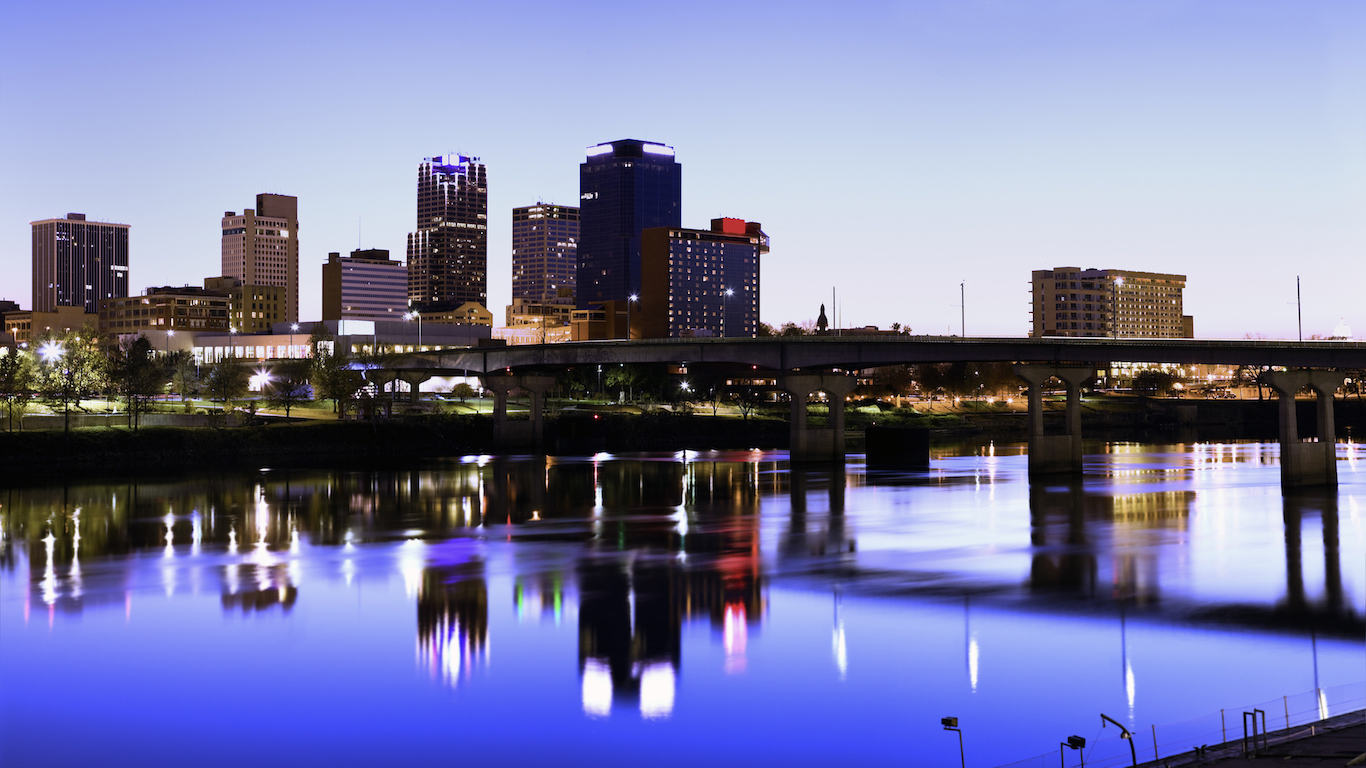
6. Arkansas
> Violent crime rate: 555 per 100,000
> Total 2017 murders: 258 (23rd most)
> Imprisonment rate: 1,050 adults per 100,000 (6th highest)
> Poverty rate: 16.4% (7th highest)
> Most dangerous city: Pine Bluff
In 2017 Arkansas reported a homicide rate of 8.6 murders per 100,000 residents, the fifth highest rate of all U.S. states. Arkansas also has the fifth highest incidence of rape and the fourth highest rate of aggravated assault. Overall there were 555 violent crimes reported per 100,000 Arkansas residents in 2017, far more than the national rate of 394 incidents per 100,000 Americans.
Several of Arkansas’ major cities report extremely high rates of crime. In 11 cities with at least 10,000 residents, the violent crime rate is more than double the national figure. In Pine Bluff there were 1,847 violent crimes reported per 100,000 residents, the most of any major city in the state.
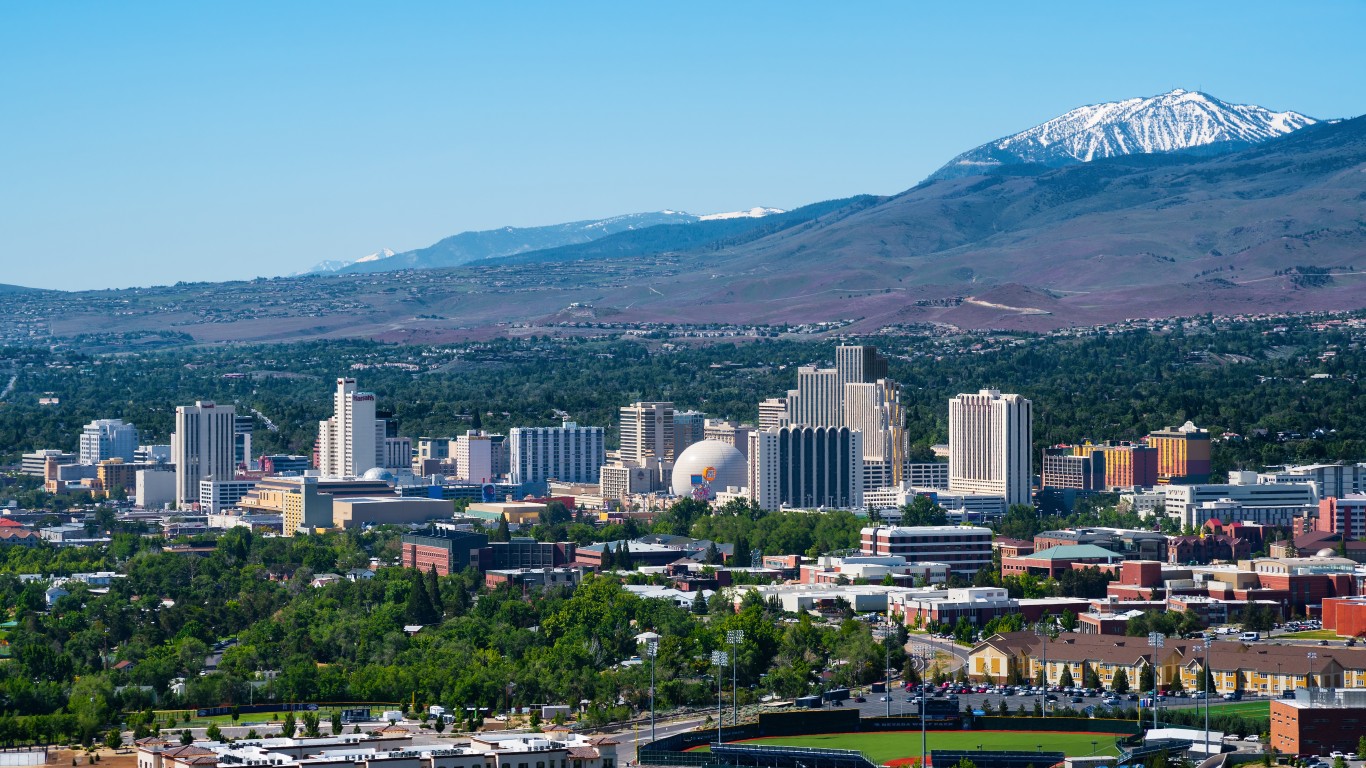
5. Nevada
> Violent crime rate: 556 per 100,000
> Total 2017 murders: 274 (21st most)
> Imprisonment rate: 890 adults per 100,000 (15th highest)
> Poverty rate: 13.0% (24th highest)
> Most dangerous city: North Las Vegas
Nevada ranks as the fifth most dangerous state with violent crime rate of 556 incidents reported per 100,000 people. The state’s murder rate and robbery rate each rank as the third highest in the country.
Though the Nevada’s 2017 violent crime rate is among the highest, it considerably lower than it was the previous year. The state’s violent crime rate in 2016 was 678 incidents per 100,000 residents — then the third highest in the country. The 18.0% drop in violent crime in 2017 was the largest of any state.
[in-text-ad]

4. Louisiana
> Violent crime rate: 557 per 100,000
> Total 2017 murders: 582 (10th most)
> Imprisonment rate: 1,270 adults per 100,000 (2nd highest)
> Poverty rate: 19.7% (2nd highest)
> Most dangerous city: Monroe
While nationwide the number of murders fell 0.7% from 2016 to 2017, in Louisiana the number of homicides rose 4.9% from 555 to 582. Adjusted for population, there were 12.4 murders reported per 100,000 residents in Louisiana in 2017, more than twice the national homicide rate of 5.3 murders per 100,000 Americans and by far the most of any state.
Though there is no one single cause of violent crime, it tends to be more common in areas facing economic challenges. In Louisiana, just 23.8% of adults have a bachelor’s degree — the fourth lowest college attainment of any state — which likely reduces the earning potential of many area residents. Approximately one fifth of residents live in poverty, the largest share of any state other than Mississippi.

3. Tennessee
> Violent crime rate: 652 per 100,000
> Total 2017 murders: 527 (14th most)
> Imprisonment rate: 930 adults per 100,000 (11th highest)
> Poverty rate: 15.0% (10th highest)
> Most dangerous city: Memphis
For every 100,000 Tennessee residents, there were 483 aggravated assaults reported in the state. That is nearly double the aggravated assault rate nationwide. Tennessee also has the ninth highest murder rate of U.S. states, with 7.8 homicides per 100,000 people.
In Tennessee, violent crime is especially concentrated in urban areas. In six cities — Memphis, Nashville, Dyersburg, Dickson, Millington, and Chattanooga — the violent crime rate is more than 1,000 incidents per 100,000 residents.

2. New Mexico
> Violent crime rate: 784 per 100,000
> Total 2017 murders: 148 (20th fewest)
> Imprisonment rate: 930 adults per 100,000 (11th highest)
> Poverty rate: 19.7% (2nd highest)
> Most dangerous city: Espanola
There were a total of 784 violent crimes — murder, rape, robbery and aggravated assault — reported per 100,000 New Mexico residents in 2017, far above the national rate of 394 incidents per 100,000 Americans and the second most of any state. Approximately 70% of all violent crime was reported in New Mexico’s urban areas. In Albuquerque, the state’s largest city, there were 1,369 violent crimes per 100,000 residents, among the most of any U.S. city. In Española, which is located about 70 miles northeast of Albuquerque, there were 2,934 violent crimes per 100,000 residents, the most of any city in New Mexico and nearly the most nationwide.
While the relationship between income and crime is complicated, violent crime tends to be more common in poor areas with limited access to economic opportunities. In New Mexico, 19.7% of the population lives in poverty, and 4.6% of the workforce is unemployed — the second highest poverty rate and fourth highest unemployment rate of any state.
[in-text-ad-2]

1. Alaska
> Violent crime rate: 829 per 100,000
> Total 2017 murders: 62 (13th fewest)
> Imprisonment rate: 800 adults per 100,000 (23rd highest)
> Poverty rate: 11.1% (16th lowest)
> Most dangerous city: Anchorage
Alaska is by far the most dangerous state in America. And the state’s violent crime rate of 829 reported incidents per 100,000 residents is more than double the national rate, and growing. The violent crime rate was 3.0% higher in 2017 than in 2016. Homicide is partially driving the increase. The 2017 murder rate of 8.4 homicides per 100,000 people — the sixth highest of any state — was 20% higher than the previous year.
Alaska has the highest rates of rape and aggravated assault in the country. For every 100,000 state residents, there were 117 rapes and 575 aggravated assaults in 2017 — both more than double the corresponding national rates.
While violent crime declined nationwide in 2017, the crime rate rose in many of the most dangerous states. In New Mexico, the second most dangerous state, the violent crime rate rose 12.0% in 2017 — the largest increase of any state other than Vermont. The spike was largely driven by an increase in crime in Albuquerque, the largest city in the state, as well as substantial increases in midsize cities such as Farmington, Clovis, and Hobbs.
Violent crime is often more prevalent in poor, densely populated urban areas, where economic opportunities for at-risk youths and adults are limited. Violent crime can have a negative impact on economic growth by reducing the supply of labor and capital in a community, and is correlated with socioeconomic factors such as unemployment and poverty.
In 11 of the 15 states with the lowest violent crime rates, the share of adults with a bachelor’s degree is above the 32.0% national college attainment rate. Similarly, the unemployment rate in 11 of the 15 least dangerous states is below the 3.7% national figure. In 14 of the 15 states with the lowest violent crime rates, the share of the population living below the poverty line is smaller than the 13.4% national poverty rate.
To determine the most dangerous states in America, 24/7 Wall St. reviewed the number of violent crimes in 2017 per 100,000 residents for all 50 states with data from the FBI’s Uniform Crime Reporting Program. Data on murder also came from the FBI. Incarceration rates are for 2016 and represent the number of people in state and federal correctional facilities per 100,000 state residents age 18 and older and are from the Bureau of Justice Statistics, a division of the U.S. Department of Justice. Data on poverty came from the U.S. Census Bureau’s 2017 American Community Survey. Unemployment rates came from the Bureau of Labor Statistics and are seasonally adjusted for September 2018. Only cities with populations of at least 10,000 were considered for the most dangerous city in every state.
Choosing the right (or wrong) time to claim Social Security can dramatically change your retirement. So, before making one of the biggest decisions of your financial life, it’s a smart idea to get an extra set of eyes on your complete financial situation.
A financial advisor can help you decide the right Social Security option for you and your family. Finding a qualified financial advisor doesn’t have to be hard. SmartAsset’s free tool matches you with up to three financial advisors who serve your area, and you can interview your advisor matches at no cost to decide which one is right for you.
Click here to match with up to 3 financial pros who would be excited to help you optimize your Social Security outcomes.
Have questions about retirement or personal finance? Email us at [email protected]!
By emailing your questions to 24/7 Wall St., you agree to have them published anonymously on a673b.bigscoots-temp.com.
By submitting your story, you understand and agree that we may use your story, or versions of it, in all media and platforms, including via third parties.
Thank you for reading! Have some feedback for us?
Contact the 24/7 Wall St. editorial team.